

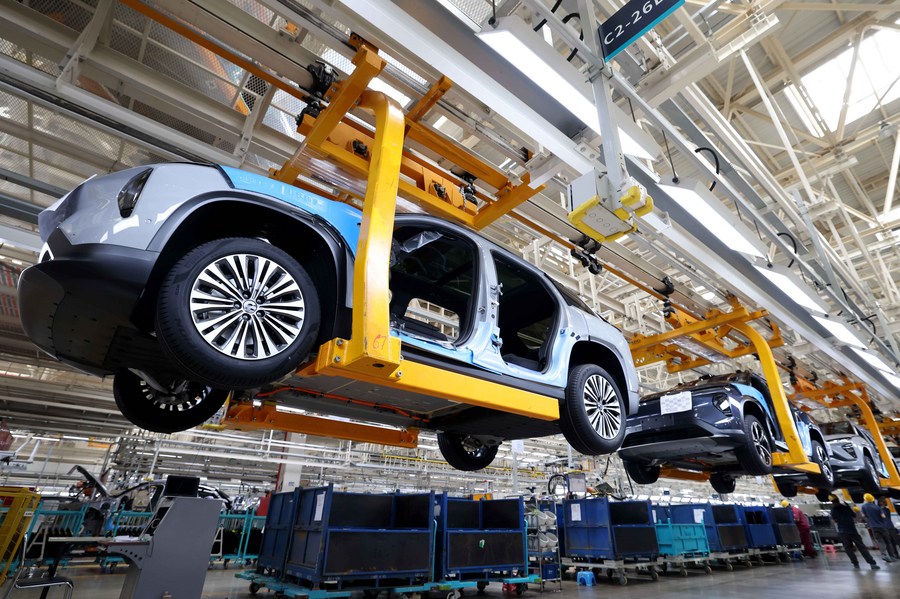
China's steadfast commitment to pursuing advanced manufacturing will help the country move up value chains, sharpen its edge amid global competition and navigate external headwinds in order to ensure sustainable economic growth, experts and corporate executives said.
Highlighting the crucial role of cutting-edge technologies in empowering China's sprawling industrial economy, they said that more policies are likely to be in the pipeline to make manufacturing higher-end, smarter and more eco-friendly.
As 2025 marks the last year of China's 14th Five-Year Plan (2021-25), the nation's emphasis on mastering core technologies in manufacturing will accelerate the transition of its development paradigm from quantity-driven to quality-driven during the 15th Five-Year Plan (2026-30) period, they added.
During his visit last month to Luoyang Bearing Group in Henan province, President Xi Jinping said: "China has always adhered to the path of developing the real economy. From the past reliance on imported matches, soap and iron, to now becoming the world's largest manufacturing country with the most complete industrial categories, we have taken the right path."
China must continue to strengthen its manufacturing sector, adhere to the principles of building self-reliance and strength, and master core technologies in key fields, he added.
Luo Zhongwei, a researcher at the Chinese Academy of Social Sciences' Institute of Industrial Economics, said that Xi's emphasis on manufacturing showed that a modern industrial system will be key to China's economic development over the next few years, and will have a profound impact.
"In the face of growing external risks, 'Made in China' needs to be backed by a stronger industrial system," Luo said.
According to Luo, countries around the world have all realized the importance of manufacturing, and China will not repeat the mistakes of some developed countries that took the path of deindustrialization and now have no choice but to work very hard to bring manufacturing back.
"I believe that manufacturing will be a key priority in China's upcoming 15th Five-Year Plan," Luo said.
Hong Qunlian, a researcher at the National Development and Reform Commission's Chinese Academy of Macroeconomic Research, said, "Manufacturing is the focal point of competition among major powers and technological supremacy. Nurturing strategic advantages for the future fundamentally relies on the high-quality development of our manufacturing industry."
"Promoting tech-driven industrial upgrading is paramount for China's real economy over the next five years. And achieving breakthroughs in critical technologies is not optional, it is essential, as we still face challenges in these areas," Hong added.
Zhang Li, president of the China Center for Information Industry Development, said, "China's economy has historically relied on the real economy, and it is through this foundation that it will continue to progress."
China has been the world's largest manufacturing country in terms of output for 15 consecutive years, and it ranks first globally in the production of over 220 industrial products, according to the Ministry of Industry and Information Technology, China's top industry regulator.
"Boasting such a complete industrial system, China provides rich application scenarios and enormous market potential for technological innovation, as well as solid support for the development of emerging industries," Zhang said.
Fresh model
Unlike some Western countries that pursued an excessive shift to services at the expense of manufacturing, China's push for new industrialization features efforts to stabilize the ratio of manufacturing business in China's GDP and does not simply phase out traditional industries, experts said.
Hong, from the Chinese Academy of Macroeconomic Research, said, "We need to coordinate the upgrading of traditional industries with the cultivation of emerging ones."
According to the ministry, China's traditional industries are vast and account for over 80 percent of the manufacturing sector.
"Traditional industries should not simply be labeled as 'low-end industries' and phased out. We must accelerate their development toward higher-end, smarter and greener directions, allowing them to 'blossom anew'," the ministry said last year.
Meanwhile, the ministry is also stepping up the push to promote the application of artificial intelligence in industrial sectors.
Li Lecheng, minister of industry and information technology, chaired a meeting in Beijing last week, outlining a comprehensive strategy to accelerate AI technological innovation and integrated application, thereby positioning AI as a core driver for China's new industrialization.
Companies are moving fast in this direction. In May, a fleet of 100 autonomous electric mining trucks began operation at an open-pit mine in the Inner Mongolia autonomous region, marking the largest-scale application of such vehicles globally.
As coal remains a key pillar of China's energy security, China Huaneng Group has partnered with XCMG Machinery and Huawei Technologies to develop a low-carbon, unmanned, intelligent transportation system.
These unmanned trucks can annually replace over 15,000 metric tons of diesel fuel, resulting in a reduction of 48,000 tons of carbon dioxide emissions. Each truck can reach comprehensive transport efficiency of 120 percent of manual operations, and it can operate continuously at temperatures as low as minus 40 C, Huaneng said.
Zhang Ping'an, CEO of Huawei Cloud, said, "This project demonstrates how 5G, cloud, AI and new energy technologies can solve core industry challenges in establishing a new paradigm for global mining."
Strategic shift
Denis Depoux, global managing director of market consultancy Roland Berger, said that China is making a strategic shift toward modern and sustainable economic growth, which "relies on factors such as advanced manufacturing, decarbonization and growing innovation prowess".
China dominates the Global Lighthouse Network list, a project launched by the World Economic Forum in collaboration with consultancy McKinsey & Co to track advanced manufacturing plants, known as "lighthouse factories", which apply state-of-the-art digital technologies.
China is now home to 79 "lighthouse factories", the highest number of any country and accounting for more than one-third of the global total.
Meanwhile, China has ever-stronger equipment manufacturing capabilities, as reflected in the fact that annual production of new energy vehicles passed the milestone of 10 million units on Nov 14, making China the only nation to realize such an achievement, the ministry said.
It took only six years for this figure to grow from 1 million to 10 million, showcasing the nation's unwavering commitment to innovation-driven development.
"Innovation stands as a pivotal force propelling the high-quality advancement of the manufacturing sector, and companies are increasingly assuming central roles in driving innovation," said Li Jinghong, an academician of the Chinese Academy of Sciences and a professor at Tsinghua University.
Ma Jun, senior vice-president of Volvo Group and president of Volvo (China) Investment, said: "We see great potential in China's AI growth. With its vast market and diverse application scenarios, China provides a unique space for AI innovation. I look forward to seeing more creative AI solutions in the transportation and infrastructure sectors, to help reduce logistics costs further and support sustainable development in China and globally."
masi@chinadaily.com.cn
Editor's note: China achieved solid gains in high-quality development after a package of incremental policies were issued, which boosted social confidence and led to a remarkable economic recovery, thereby enabling the accomplishment of the main targets of socio-economic development.
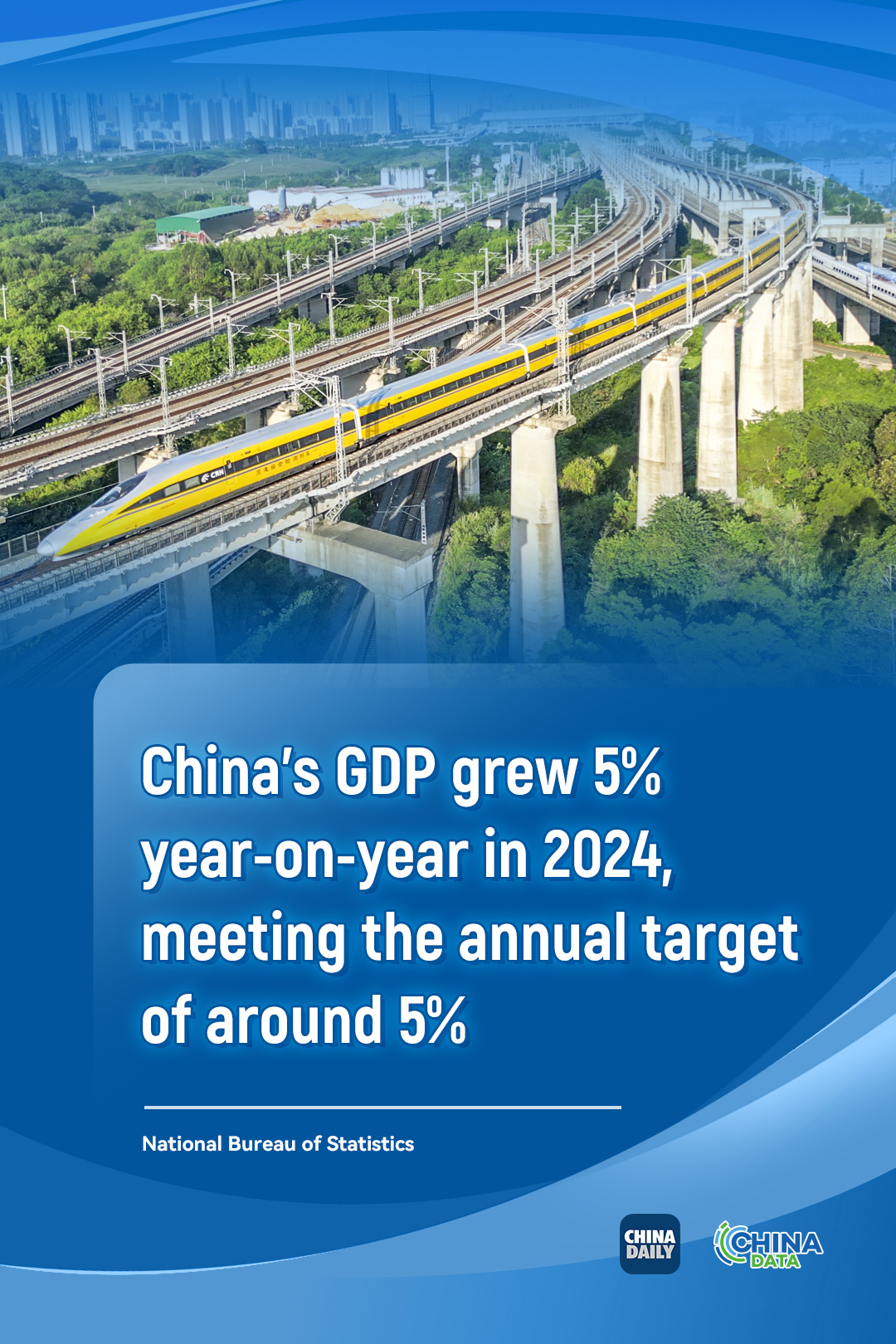
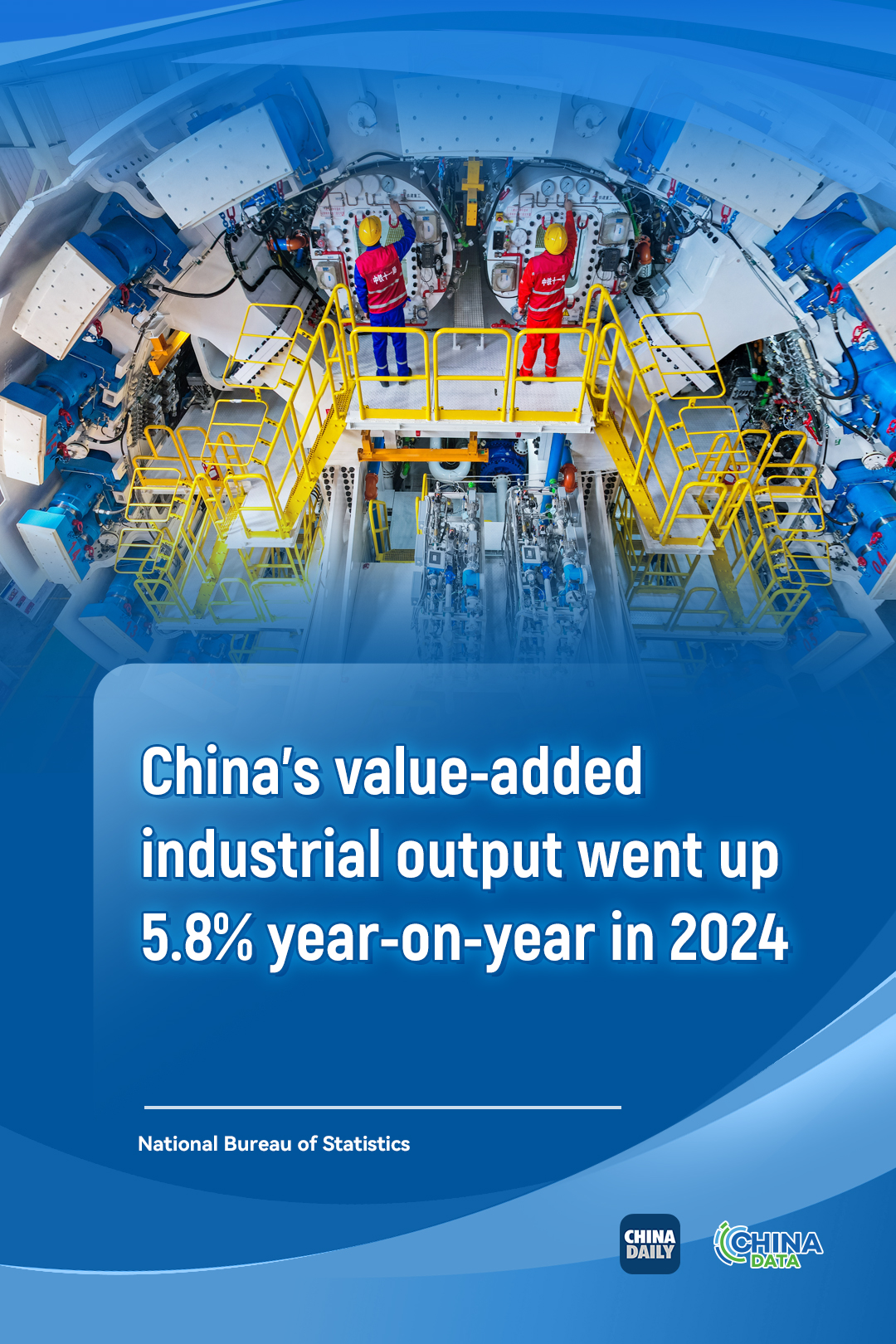

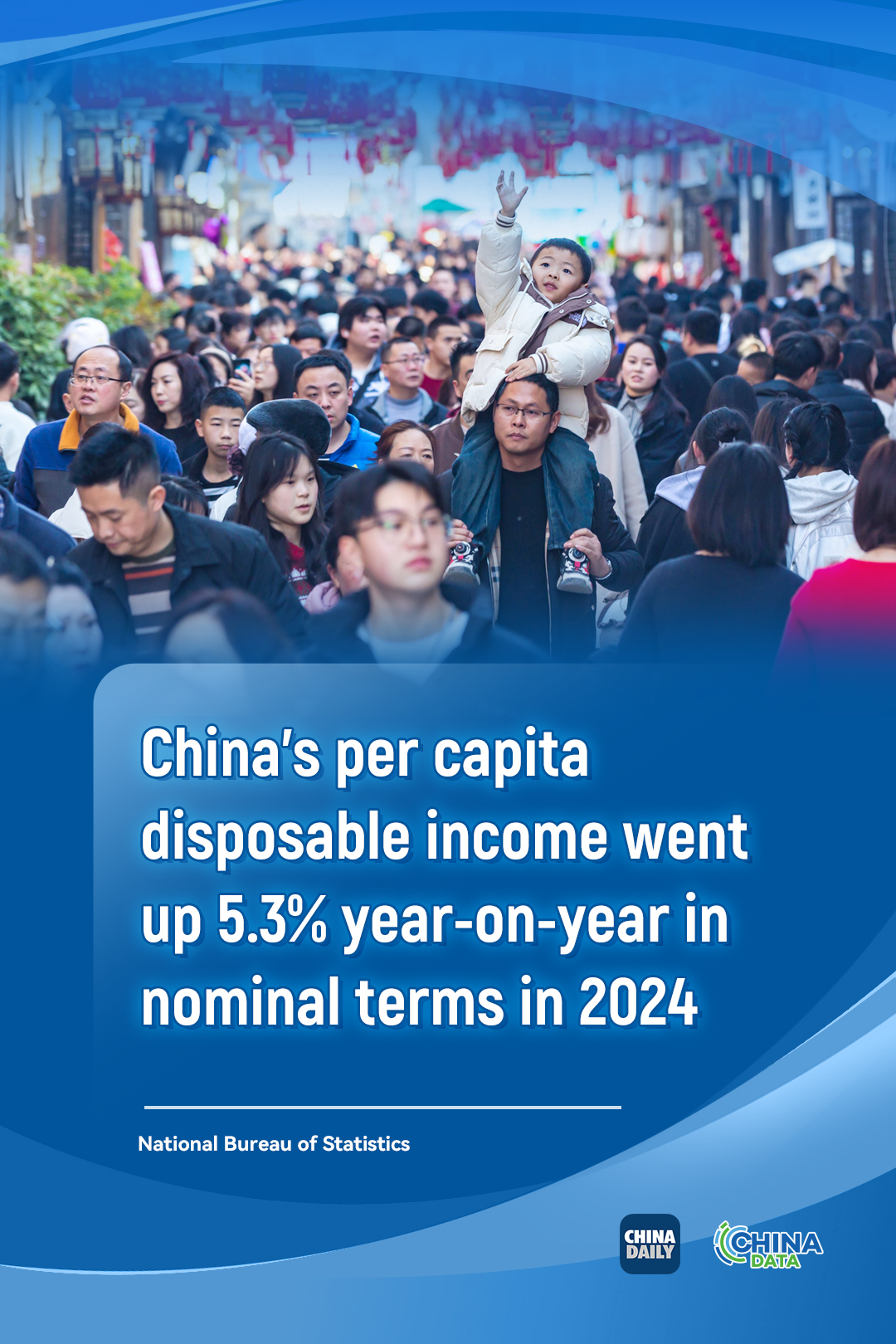
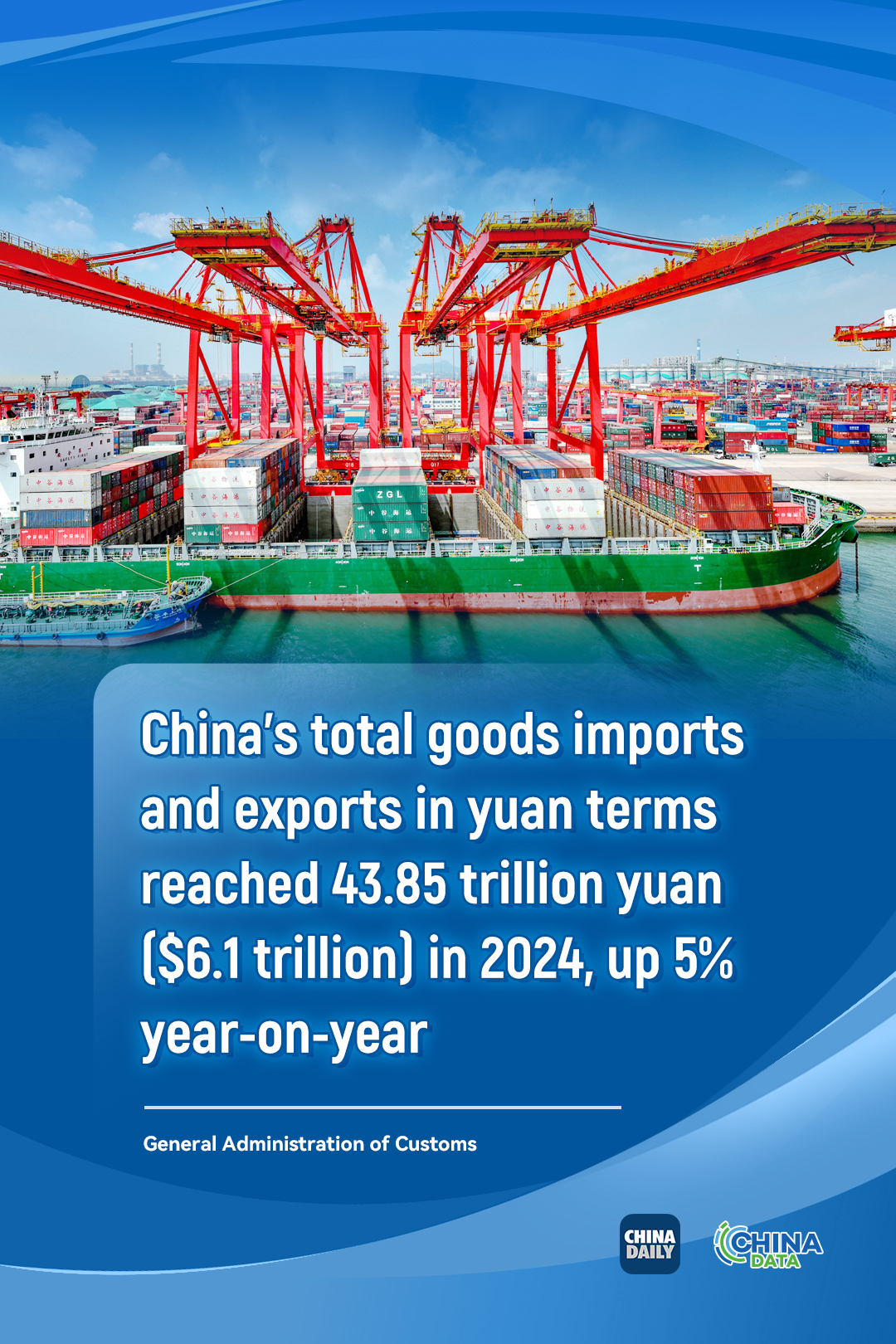
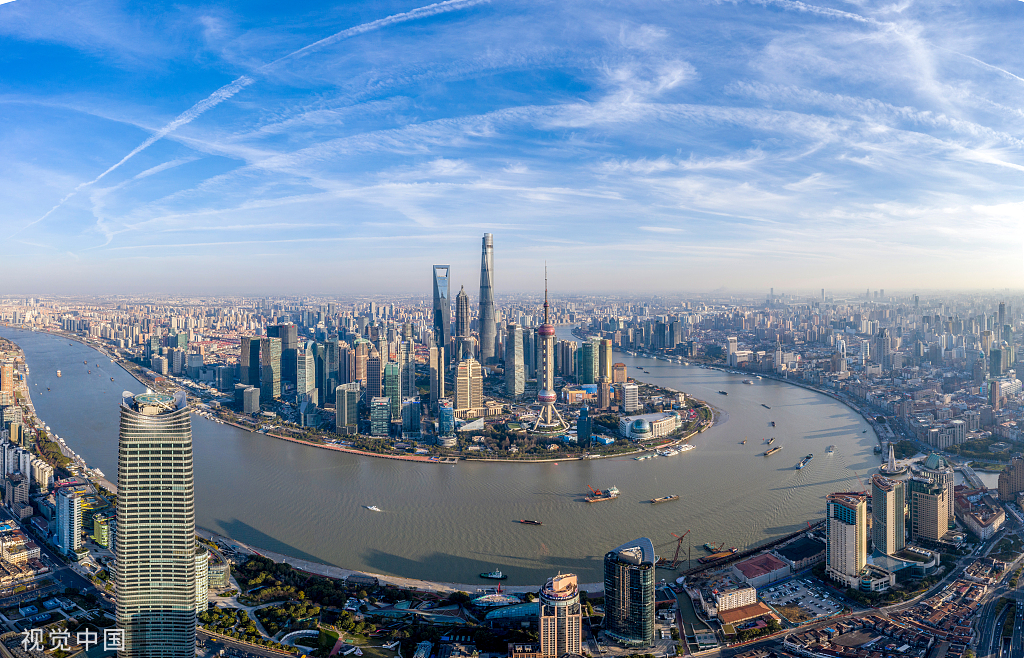
China will continue to relax market access, expand institutional openness and foster a more enabling business climate, in order to better attract and utilize foreign investment, especially in the face of rising global protectionism and escalating geopolitical tensions, officials and experts said on Wednesday.
As persistent economic headwinds have dampened the confidence of global investors, China's supersized market, coupled with its robust manufacturing capabilities and extensive supply chain networks, has become a major draw for foreign companies looking to expand their global footprint, they said.
Addressing a news conference, Li Yongjie, deputy international trade representative of the Ministry of Commerce, said, "China will further open up its services sector, with a particular focus on accelerating pilot programs in key areas such as telecommunications, healthcare and education."
China has been revising its list of sectors in order to encourage foreign investment, Li said, noting that such measures, coupled with the removal of all market access restrictions for foreign investors in the manufacturing sector last year, signal the country's proactive stance toward openness.
The country is committed to aligning itself with high-standard international trade and economic rules, while building high-level opening-up platforms such as free trade zones, Li said, adding that it will continue to make efforts to improve the overall business environment.
In the first 11 months of 2024, more than 52,000 foreign-invested enterprises were newly established in China, a year-on-year increase of 8.9 percent and the highest level on record for the same period, according to the ministry.
Jean-Paul Agon, chairman of L'Oreal Group, said: "Success in China makes you stronger worldwide. That is why we firmly believe that the next China is still China and that investing in China is investing in our future."
Last week, the Ministry of Foreign Affairs said at a news conference that in the past five years, the return rate on direct investment in China by foreign investors stood at about 9 percent, ranking among the highest in the world.
Gao Lingyun, a researcher at the Chinese Academy of Social Sciences, said that amid intensifying global uncertainties, China's unwavering commitment to opening-up, a vast consumer base, a complete industrial system and robust manufacturing capabilities offer unique advantages that are increasingly appealing to foreign investors.
In November, China issued revised regulations for foreign investors in its listed companies, expanding the eligibility criteria and easing financial requirements in a bid to encourage foreign investors to make long-term and value investments.
"China's ongoing efforts to lower foreign investment barriers and improve its business environment have significantly enhanced the country's appeal as a prime destination for global investors," Gao added.
According to a survey released by the German Chamber of Commerce in China in December, 92 percent of German companies intend to continue their operations in the country. Notably, more than half of the respondents said they plan to boost their investments in the next two years.
Similarly, businesses in the United Kingdom will stabilize their investments in China despite challenges, with about 76 percent of UK companies maintaining or increasing their investments in the Chinese market, a survey released by the British Chamber of Commerce in China showed in December.
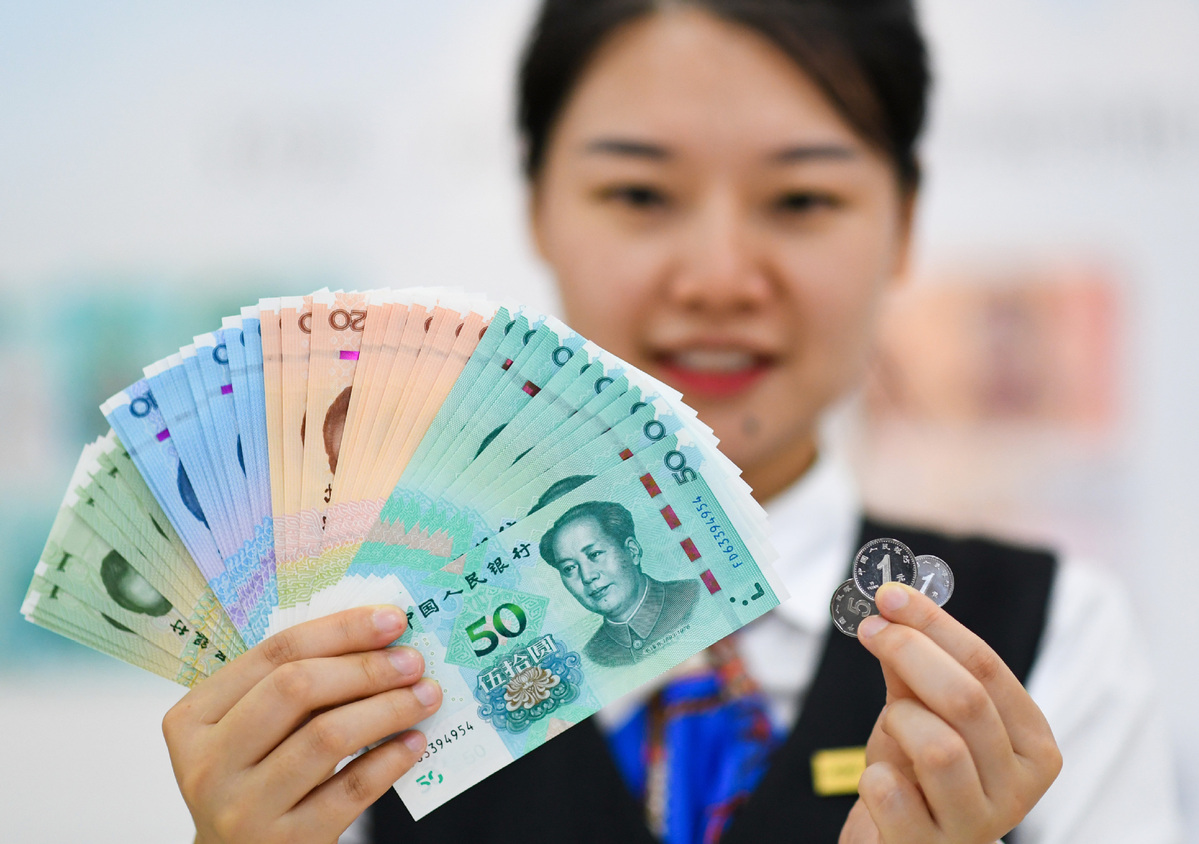
Offshore renminbi bond issuances more than doubled last year while panda bond issuances surged, highlighting the steady progress made by the Chinese currency in gaining traction in global markets, official data showed on Tuesday.
The People's Bank of China, the country's central bank, said that the issuances of panda bonds — onshore renminbi bonds issued by overseas financial institutions and enterprises — reached almost 200 billion yuan ($27.3 billion) in 2024, a 32 percent increase from the previous year.
Meanwhile, the issuances of offshore yuan bonds saw a 150 percent year-on-year growth last year, the PBOC said on Tuesday.
"Various indicators of the international use of the yuan have steadily improved, with the ability of cross-border yuan business to serve the real economy continuously enhanced," Xuan Changneng, deputy governor of the PBOC, said at a news conference.
The yuan has emerged as the fourth most used payment currency and one of the top three trade financing currencies, Xuan said, adding that cross-border yuan payments and receipts reached about 64 trillion yuan last year, a 23 percent year-on-year increase.
The balance of offshore yuan deposits has exceeded 1 trillion yuan, while the offshore yuan loan balance approached 700 billion yuan, both at historically high levels, the PBOC said.
Over 80 overseas central banks and monetary authorities have included the yuan in their foreign exchange reserves.
BEIJING -- China's cross-border receipts and payments by non-banking sectors hit a record high in 2024, an official with the State Administration of Foreign Exchange (SAFE) said on Tuesday.
The cross-border receipts and payments by non-banking sectors increased by 14.6 percent year-on-year to $14.3 trillion last year, Li Bin, deputy head of the SAFE, told a press conference held by the State Council Information Office.
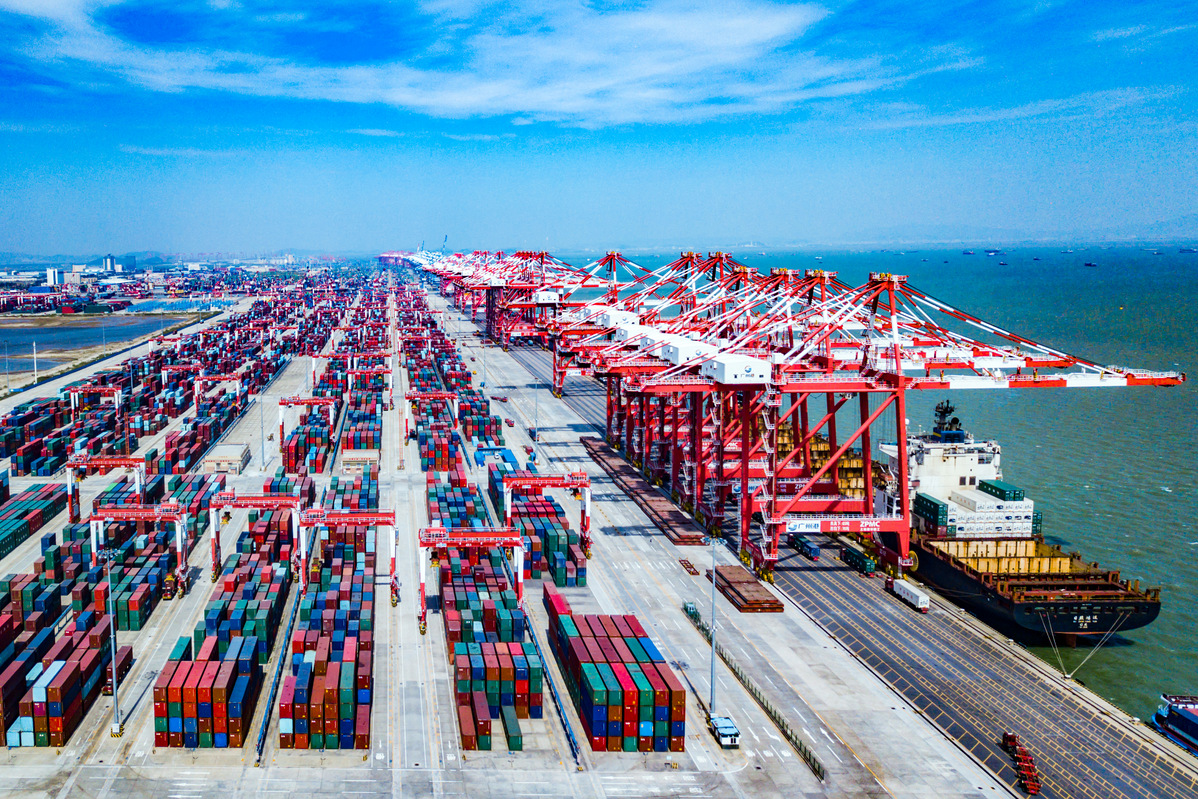
Despite growing external challenges and uncertainties, China's exports will remain resilient and dynamic in 2025, bolstered by a diverse product range, flexible growth drivers and a stable, multifaceted market, said government officials and exporters on Monday.
Addressing a news conference in Beijing, Wang Lingjun, deputy head of the General Administration of Customs, said that Chinese-manufactured products are in high demand worldwide, driven by a strong and continuously evolving industrial system and sustained investment in innovation.
China's established manufacturing supply chain will play a crucial role in maintaining the stability of global production and supply networks, while driving technological progress and industrial upgrades across the world, Wang said.
The total value of China's foreign trade reached a record high of 43.85 trillion yuan ($6 trillion) in 2024, marking a 5 percent year-on-year growth, customs statistics showed.
The country's exports amounted to 25.45 trillion yuan last year, an increase of 7.1 percent year-on-year, while imports totaled 18.39 trillion yuan, a 2.3 percent rise compared with the previous year.
In the fourth quarter of 2024, China's exports grew 9.2 percent year-on-year, marking an acceleration of 2.9 percentage points compared with the first three quarters, according to the GAC.
This not only reflected the continuation of a long-term positive trend but also demonstrated the effectiveness of recent policy implementations, said Lyu Daliang, director of the administration's department of statistics and analysis.
Liang Ming, director of the Institute of International Trade, which is part of the Chinese Academy of International Trade and Economic Cooperation, said that China's advantages include the expanding share of electromechanical products in total export value, the fast development of industrial clusters for tech-intensive green products, the rapid growth of cross-border e-commerce businesses, and the growing interest of exporters in digital and green trade. These factors will help strengthen the foundation of China's foreign trade growth this year, Liang added.
To address challenges such as the rise of unilateralism and potential disruptions in global supply chains, China is likely to introduce new policies to stabilize foreign trade in 2025, said Liu Xiangdong, a researcher at the Beijing-based China Center for International Economic Exchanges.
These policies, particularly in areas like fiscal policy and financing, will focus on strengthening support for foreign trade companies, Liu added.
As many international organizations predict moderate global trade recovery in 2025, with emerging economies driving trade growth, he said this will help China diversify its trade partners, increasing emerging markets' share in foreign trade and effectively mitigating uncertainties and risks associated with changes in traditional markets.
In a testing workshop of Jiangsu Newamstar Packaging Machinery, a manufacturer of packaging machinery for liquids in Zhangjiagang, Jiangsu province, workers conducted the final pre-shipment adjustments earlier this month on a bottle blowing-filling-capping machine.
Within just one minute, 433 bottle preforms can be transformed into beverage bottles. A beverage packaging production line corresponding to the machine will be shipped to the client's plant in India. All the machines will be installed, adjusted and put into production before the peak beverage sales season.
"We have exported more than 2,200 production lines to over 80 countries and regions globally to date," said Yin Gang, a manager at the company's marketing unit. Yin added that the company plans to invest further in innovation and expand its markets in the Middle East, South Asia and Southeast Asia this year.
China saw growth in exports to more than 160 countries and regions in 2024, including a 9.6 percent year-on-year rise in exports to economies participating in the Belt and Road Initiative, and a 13.4 percent year-on-year increase to the Association of Southeast Asian Nations, according to the GAC.
In addition, Chinese exports to the United States grew 6.1 percent year-on-year, while those to the European Union grew 4.3 percent.
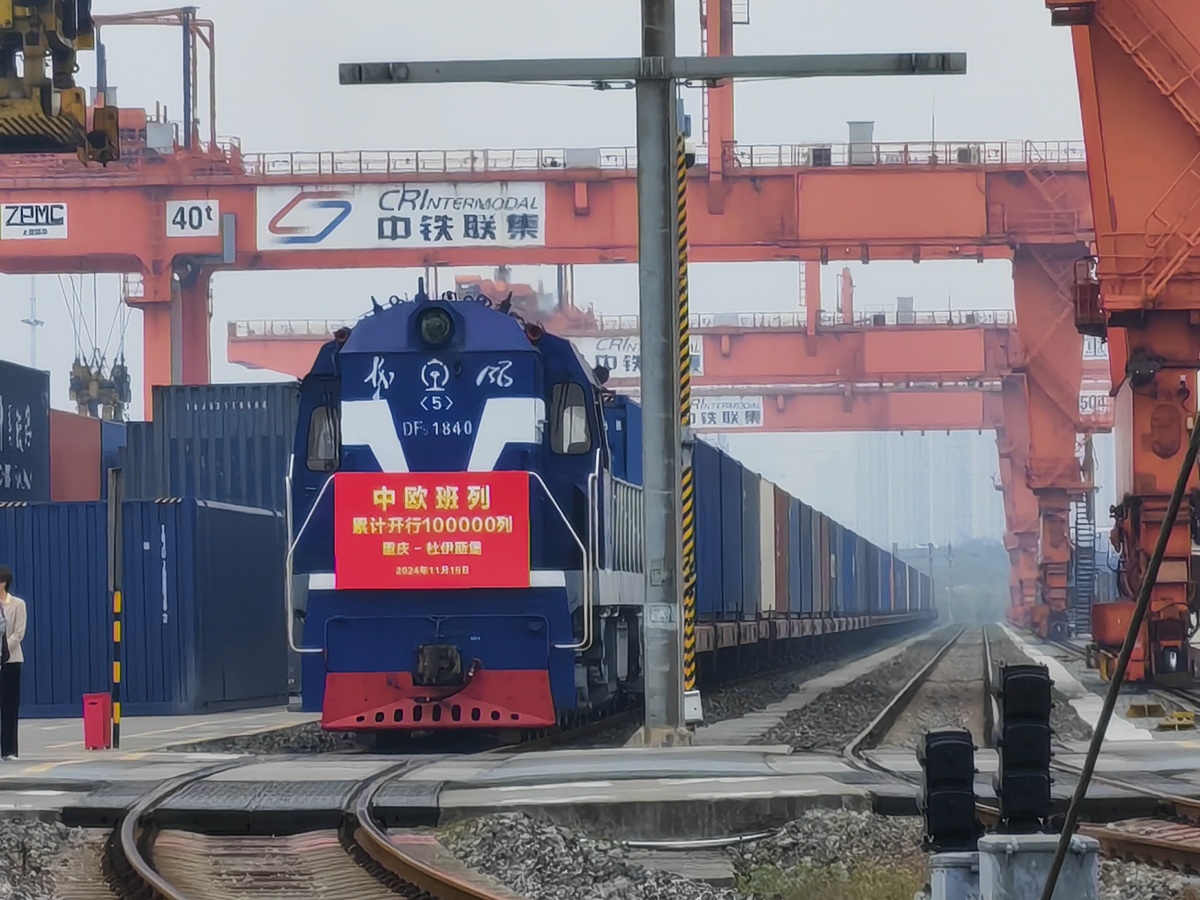
BEIJING - China does not pursue a trade surplus, and the country's trade balance is shaped by broader international market forces rather than deliberate intervention, an official said on Monday.
Wang Lingjun, deputy head of the General Administration of Customs, made the remarks in response to a question about the trade surplus during a press conference on China's 2024 trade performance.
"China does not aim for a trade surplus. The specific levels of exports, imports and trade balances are the result of international supply-and-demand dynamics, industrial division of labor and market competition," Wang said.
He noted that China's trade surplus, as a percentage of gross domestic product, is within a reasonable range and has significantly declined from historical highs, remaining below levels seen in other major exporting nations.
Wang also criticized some countries for imposing tighter export controls on China, calling such policies contradictory. "China wants to increase imports, but if you don't let the goods in, and then you worry about our trade surplus, that's inherently inconsistent," he noted.
China has actively worked to diversify imports, Wang said, citing the annual China International Import Expo, lower tariffs and expanded market access as key steps. These measures have not only driven record-high import volumes but also enabled more countries and businesses to benefit from opportunities in the Chinese market, fostering more balanced trade growth.
Wang further addressed concerns about rising trade protectionism, referencing the World Trade Organization's Global Trade Report 2024. The report warns that protectionist policies will harm the economic growth of all nations.
Despite external headwinds, Wang said China remains committed to expanding openness, opposing protectionism and championing win-win cooperation.
China will continue to open its doors wider with unwavering determination, Wang said, noting that through practical actions, China will foster collaboration, share opportunities and promote development with all countries.
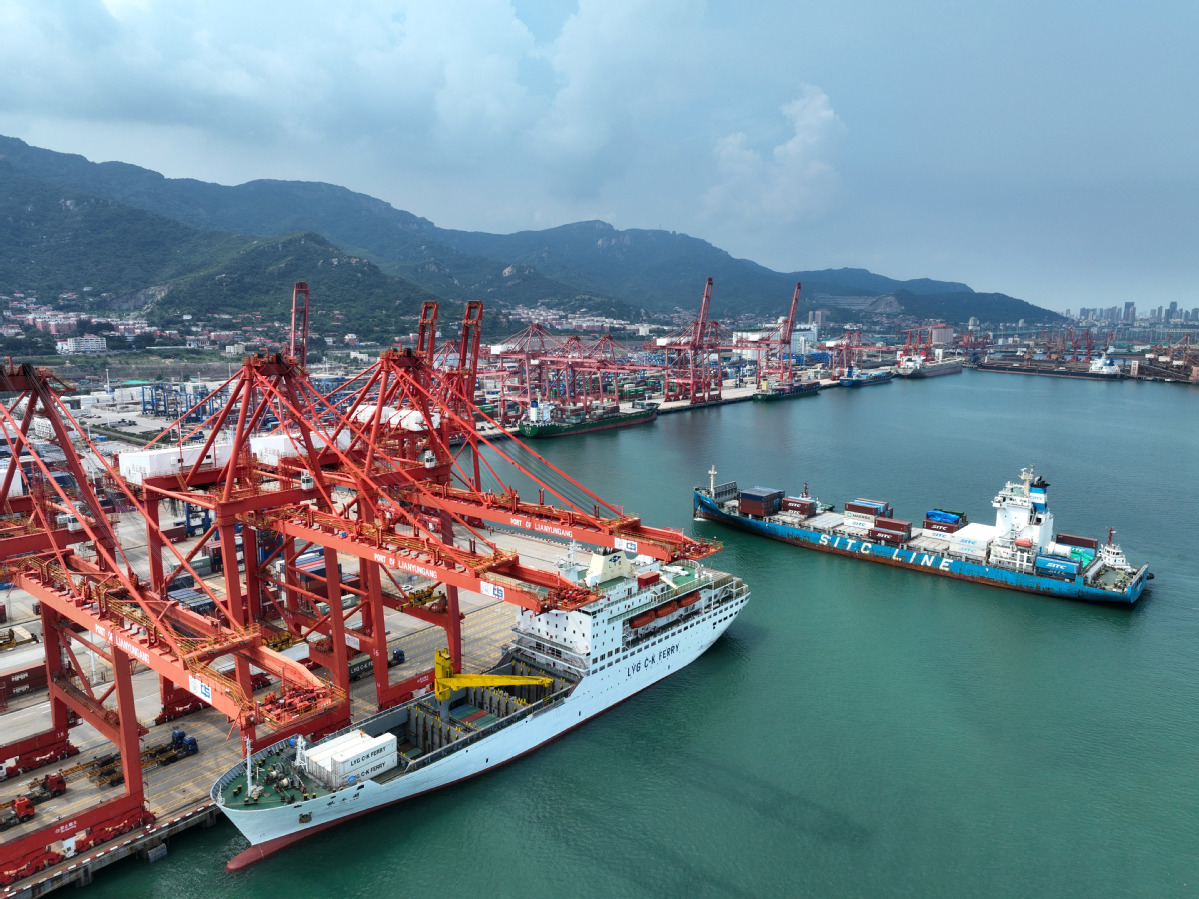
BEIJING - The so-called "overcapacity" in China's exports is pure fallacy, said a Chinese customs official on Monday.
There is no such thing as overcapacity in China, whether viewed from the perspective of comparative advantage or global market demand, Wang Lingjun, deputy head of the General Administration of Customs, told a press conference when responding to a question about the US government's claim of overcapacity in Chinese exports.
Chinese manufacturing, which is widely popular in the global market, relies on a comprehensive and continuously upgraded industrial system, as well as ongoing investment in research and development and innovation, Wang noted.
It is evident and undeniable that the country's complete manufacturing supply chain ensures the stability of global production and supply chains, driving technological advancement and industrial upgrading worldwide, said the official.
The repeated claims by some countries are essentially an attempt to suppress and hinder China's development, representing a form of protectionism that seriously undermines global industrial cooperation and supply chain stability, Wang said, adding that upholding open cooperation and mutual benefit is the correct direction for global economic development.
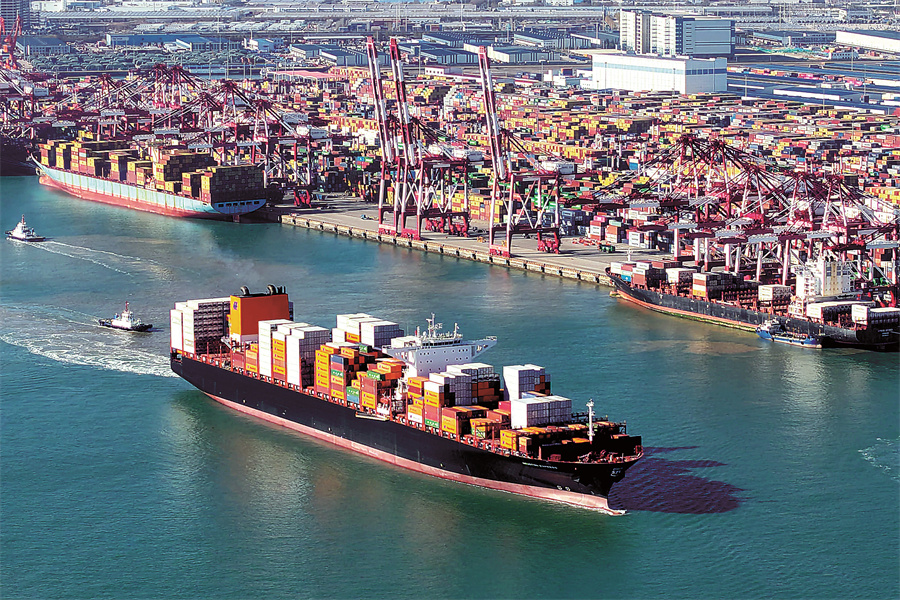
The total value of China's foreign trade reached a record high of 43.85 trillion yuan ($5.98 trillion) in 2024, marking a 5 percent year-on-year growth, statistics from the General Administration of Customs showed.
China's exports amounted to 25.45 trillion yuan last year, reflecting a 7.1 percent year-on-year increase, while imports totaled 18.39 trillion yuan, marking a 2.3 percent rise compared to the previous year.
The administration said that China remains the world's largest goods trader. The country has become a major trading partner for over 150 countries and regions.
In terms of quality of trade, China's structure of imported and exported products has been optimized and upgraded, said Wang Lingjun, vice-minister of the GAC.
At a news conference in Beijing, Wang highlighted the encouraging momentum of China's trade growth in high-tech products, noting that exports of self-owned branded products have reached a new record and new business models, such as cross-border e-commerce, have thrived.
China, with more forceful countercyclical adjustments in mind, will steer toward "very proactive" fiscal policy this year — including increasing the deficit-to-GDP ratio and issuing larger-scale government bonds, and will "front-load" its fiscal firepower to better underpin a positive economic growth trajectory, Vice-Minister of Finance Liao Min said on Friday.
As China navigates the everchanging domestic and international landscapes, policymakers are well-equipped with "ample policy space and a diverse tool kit", Liao said at a news conference, stressing that the country will resort to policy reserves should new circumstances call for them.
"Given the steady growth in China's GDP, the increase in the deficit ratio will translate into a substantial expansion of the overall budget deficit, allowing for a further increase in total fiscal expenditures and a more forceful implementation of countercyclical adjustments," Liao said.
Liao added that the specific figure will only be disclosed after going through the necessary legal procedures. Analysts estimate the deficit-to-GDP ratio might be as high as 4 percent.
In the face of a property market that still seeks a solid footing in its recovery, and uncertainties clouding the export sector due to rising global protectionism, leveraging potent fiscal tools to boost domestic demand is vital for sustaining the country's growth momentum, said Luo Zhiheng, chief economist at Yuekai Securities.
To this end, a deficit target of as high as 4 percent of GDP, according to Luo, could be considered this year, up from the current 3 percent goal set for 2024.
China's ratio is considerably lower than that of major economies and emerging markets, pointing to an overall sound and sustainable fiscal position. And government debt is backed by a substantial amount of high-quality assets that generate both social and economic returns, said Liao.
In particular, China's current real interest rate on government debt is notably lower than the country's actual economic growth rate, further indicating the country's sizable debt tolerance capacity and scope for deficit expansion, Liao added.
"With the rising deficit ratio, we anticipate a notable expansion in bank credit and social capital investment, which will in turn promote a significant increase in effective domestic demand," he said.
Liao also made it clear that the country will expand the scale of government bond issuances, including ultralong special treasury bonds and local government special-purpose bonds.
The scale of ultralong special treasury bonds is expected to be expanded from 1 trillion yuan ($136.38 billion) in 2024 to around 1.5 to 2 trillion yuan this year, to better support the country's large-scale equipment upgrades and consumer goods trade-in initiatives, said Wang Qing, chief macroeconomic analyst at Golden Credit Rating International.
The new issuance of local government special-purpose bonds this year is expected to expand from 3.9 trillion yuan in 2024 to around 7 trillion yuan, including a 2.8 trillion yuan debt swap quota, Wang said.
Local authorities will be permitted to direct special-purpose bonds toward the purchase of land reserves, as well as the acquisition of existing commercial properties for the purpose of providing affordable housing, said Lin Zechang, head of the ministry's comprehensive department.
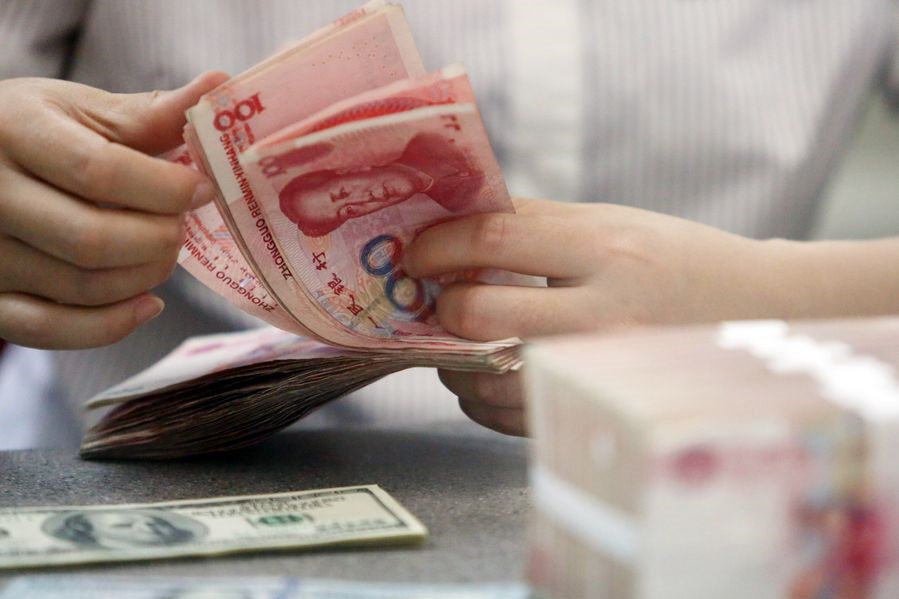
BEIJING - The size of China's fiscal deficit will increase significantly in 2025, Liao Min, vice-minister of finance, told a press conference Friday.
Noting that the fiscal deficit ratio will be increased in 2025, Liao said considering the increasing size of China's GDP, the total fiscal expenditure will further be expanded, and countercyclical adjustment efforts will also be stepped up to provide solid support for the sustained recovery of the economy.
Meanwhile, the fiscal policy in 2025 has a clear and well-defined course, fully accounts for the need to enhance countercyclical adjustments, and is highly proactive, he said.
The policy also takes fiscal sustainability in the medium and long term into consideration, so that it is prudent at the same time, said Liao.
Specific policy measures must go through statutory procedures before being launched, the vice-minister said.
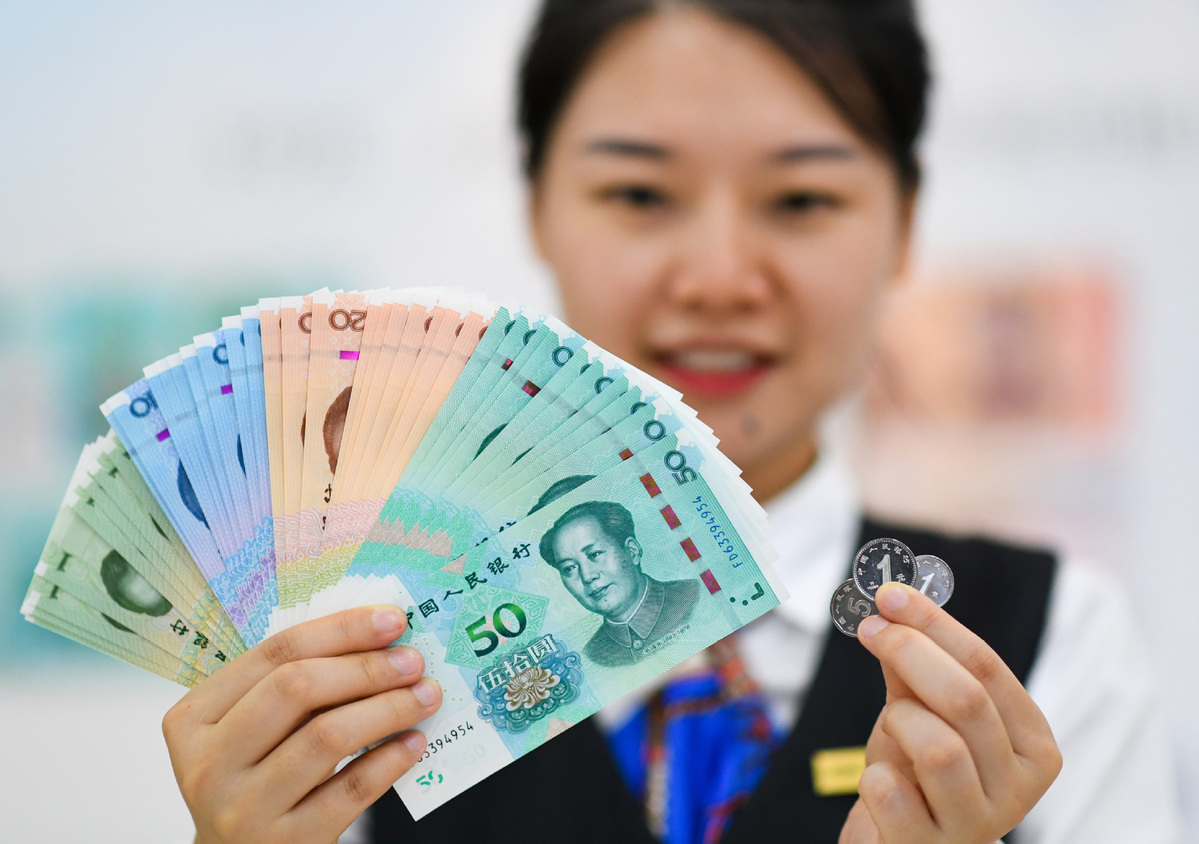
BEIJING - China's fiscal operation was generally stable in 2024 and is expected to achieve a balanced budget for the year, China's Vice-Minister of Finance Liao Min said Friday.
BEIJING -- The number of registered business entities in China rose 3.1 percent year-on-year to 189 million by the end of 2024, an official from the State Administration for Market Regulation said on Friday.
In the first three quarters of last year, the country saw about 7.22 million newly-registered business entities handling tax-related businesses, expanding 17.4 percent year-on-year, Shu Wei, deputy head of the administration, told a press conference.
Consumer rights protection efforts have also seen advancements, with authorities recovering over 4.72 billion yuan ($656.69 million) in economic losses from complaints and reports, up 17.1 percent year-on-year, Shu said.
The progress reflects broader regulatory efforts aimed at fostering a fair market environment, including targeted support for individual businesses and stricter law enforcement to safeguard the legitimate rights of business entities, Shu said.
Efforts to improve competition in the platform economy have been intensified, alongside initiatives to transform traditional industries, cultivate emerging industries, and plan for future industries, with a focus on enhancing the resilience of industrial chains, he added.

The State Administration for Market Regulation, the country's top market regulator, said on Friday that it plans to implement stringent oversight of online platforms and livestream e-commerce, as part of a broader effort to ensure fair competition and protect smaller businesses.
Speaking at a press briefing of the State Council on Friday, the nation's Cabinet, Shu Wei, deputy head of the SAMR, said more efforts will be made to make platform rules more transparent, lower operational costs for merchants and clean up the e-commerce ecosystem, to ensure a healthier market environment.
"We will improve regulatory frameworks and address the abuse of platform rules that disrupt fair competition and harm the rights of merchants and consumers," Shu said.
He emphasized that SAMR will also crack down on deceptive marketing in the livestream e-commerce sector.
The move reflects Beijing's broader push to drive the healthy development of the country's platform economy to foster innovation and prevent monopolistic behaviors.
Shu said the goal of such efforts is to create an environment where "towering trees" of major platform companies can coexist with "lush green grass" of smaller enterprises. "We want to see a vibrant ecosystem that promotes growth and prosperity across the board," he added.
chengyu@chinadaily.com.cn
China has made new progress in water management over the past year. Click the video to see the highlights.
China has made new progress in water management over the past years. Here are some highlights.
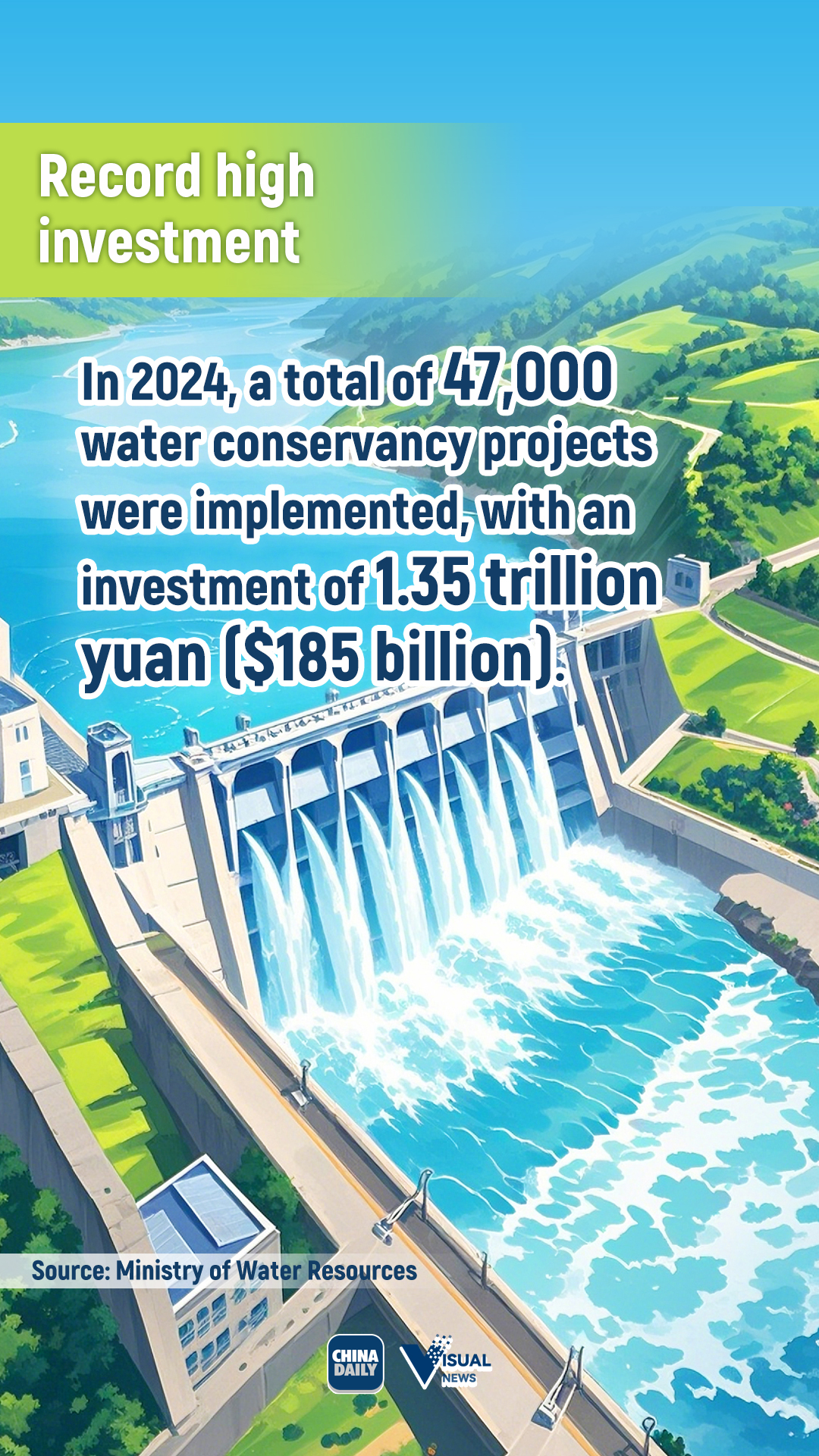
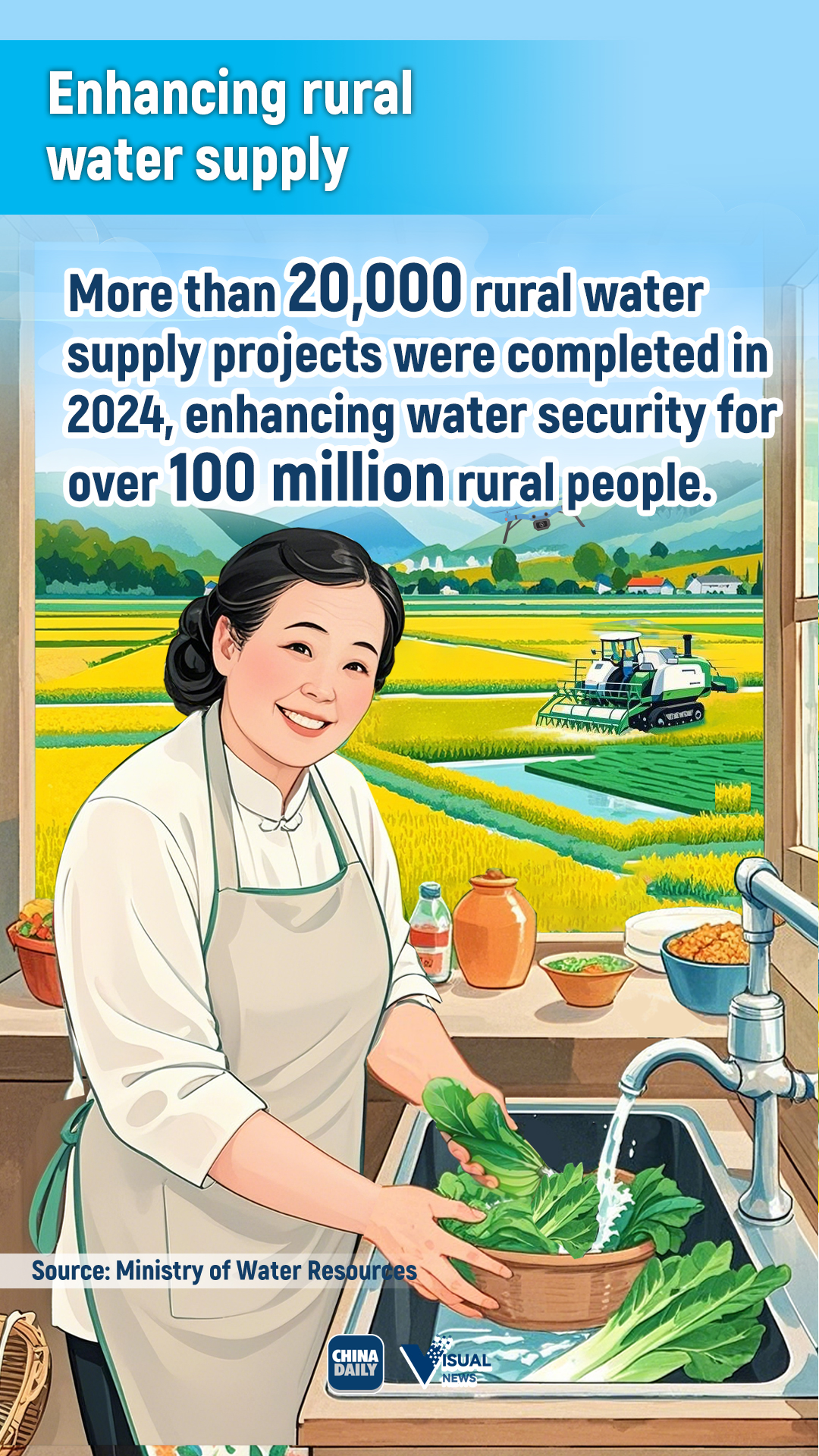
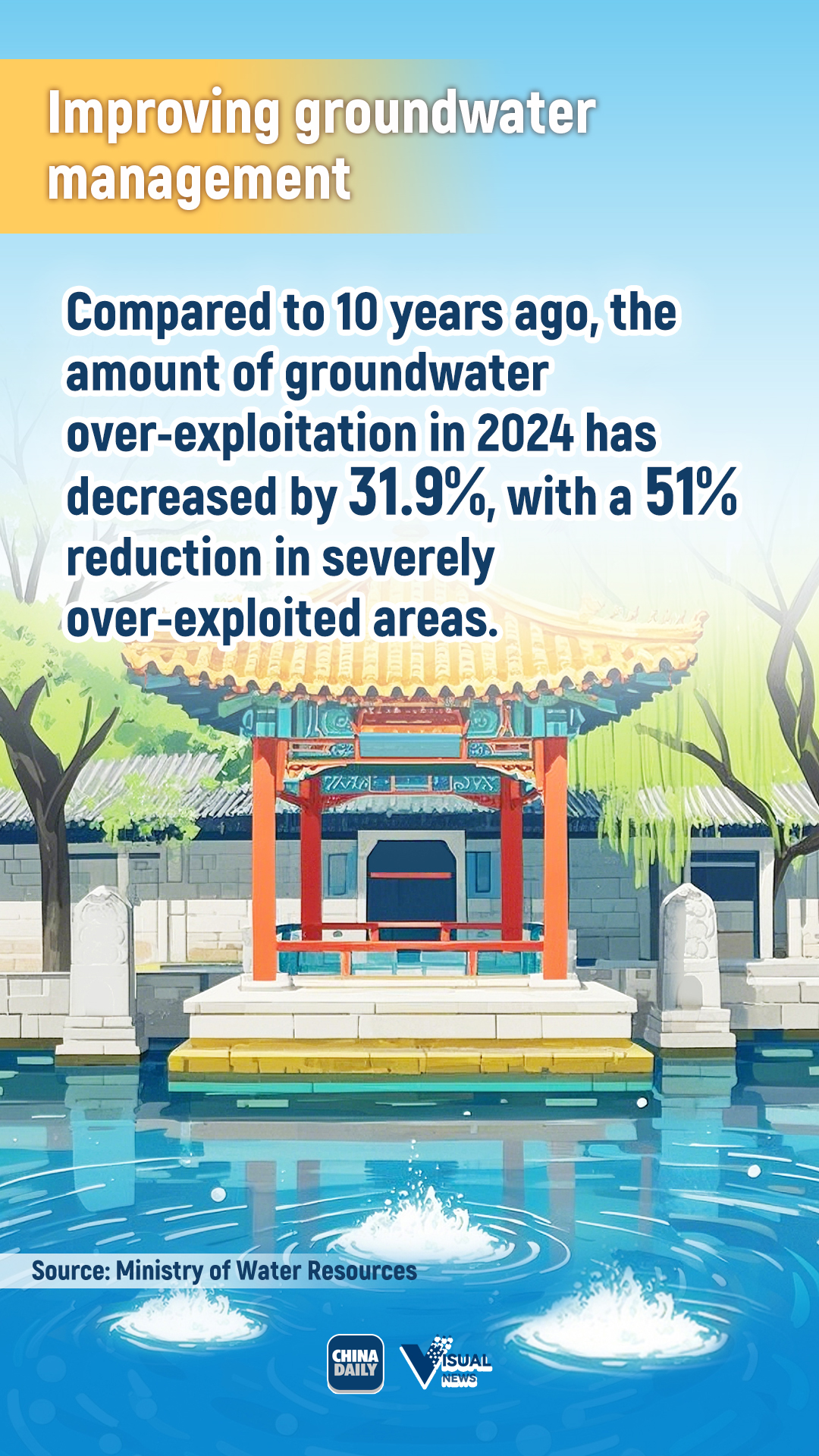
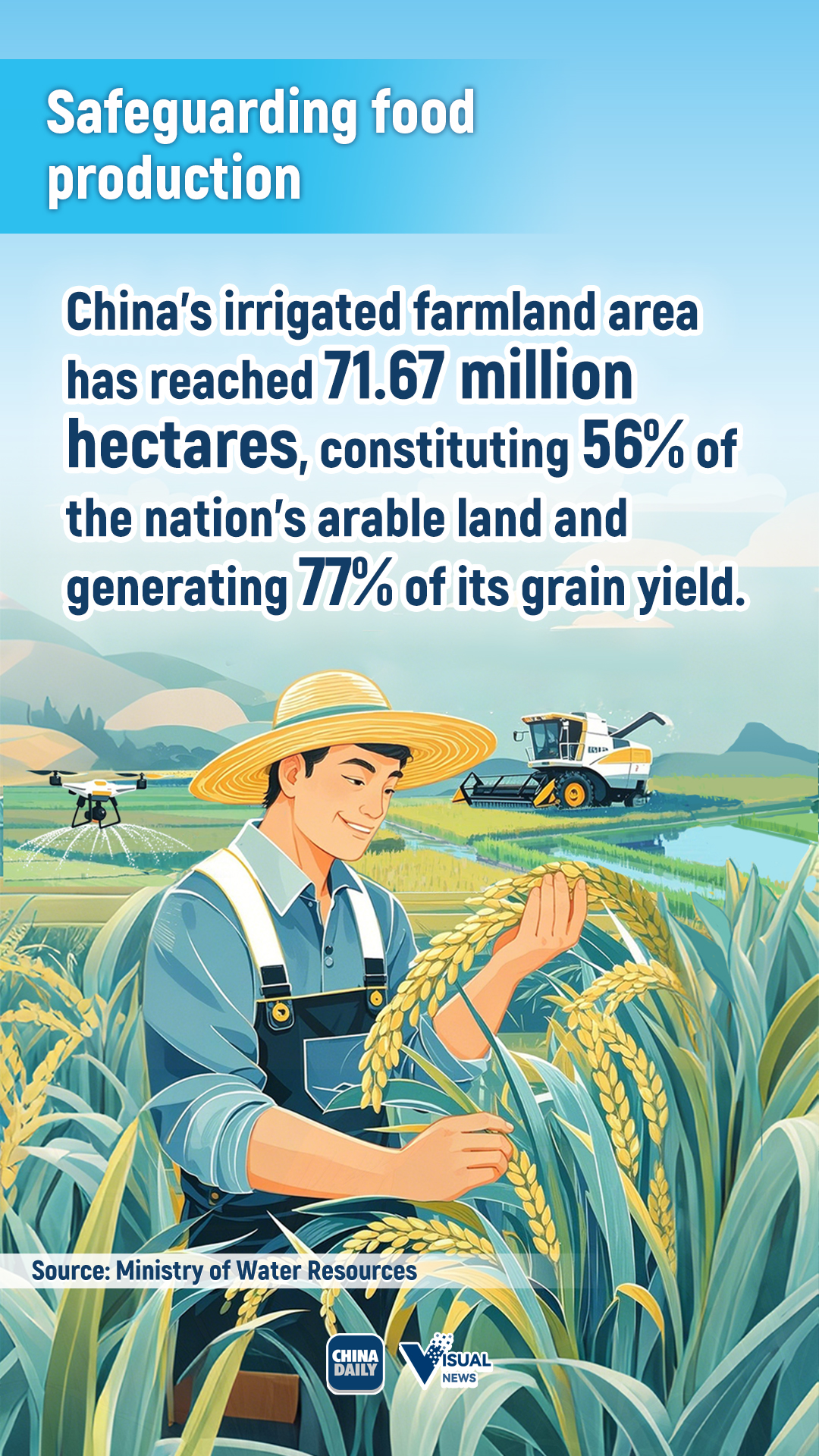
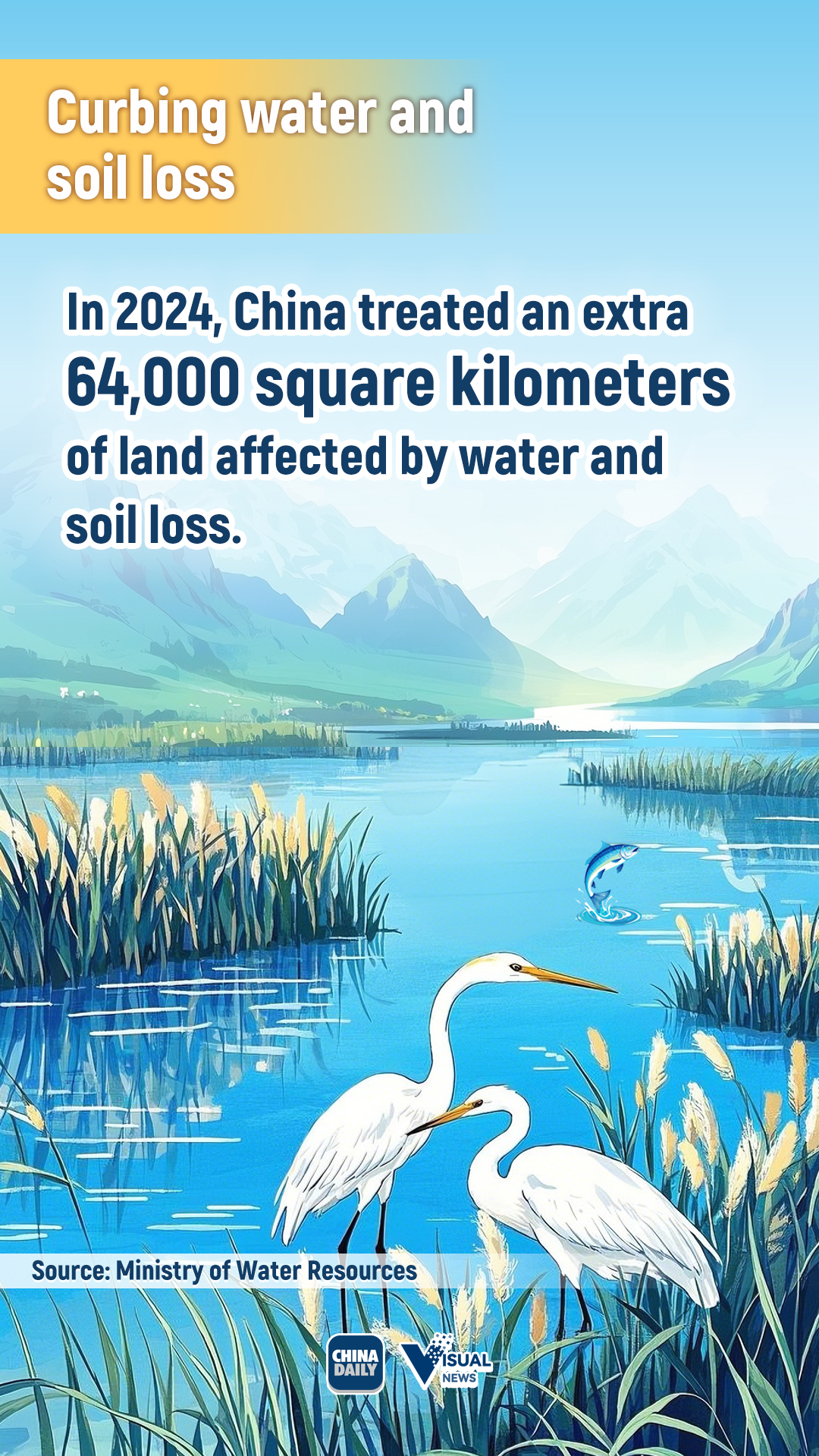
Editor's note: China has made remarkable achievements in high-quality development last year, with the country's strength in economy, technology, environment and public services continuing to increase.
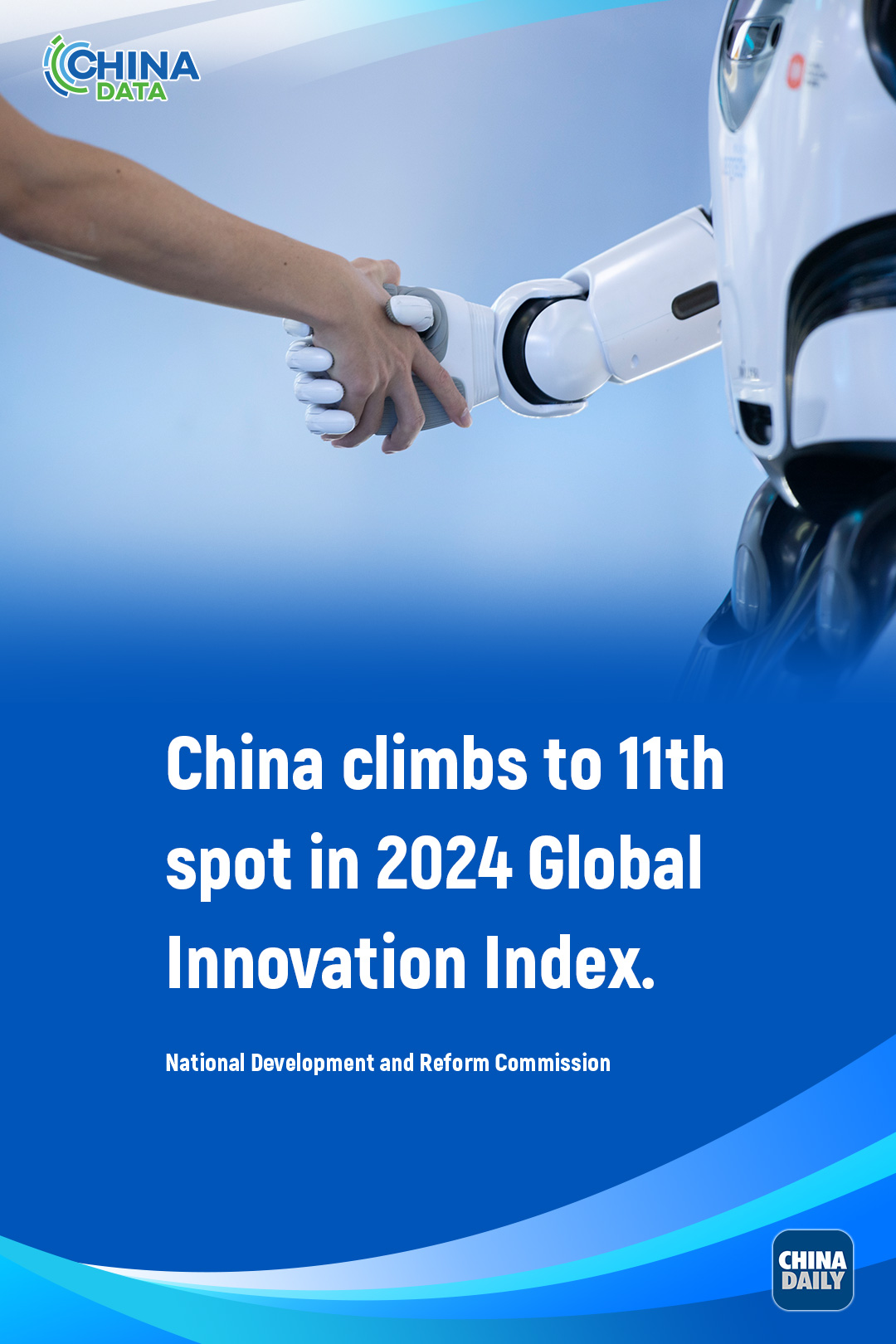
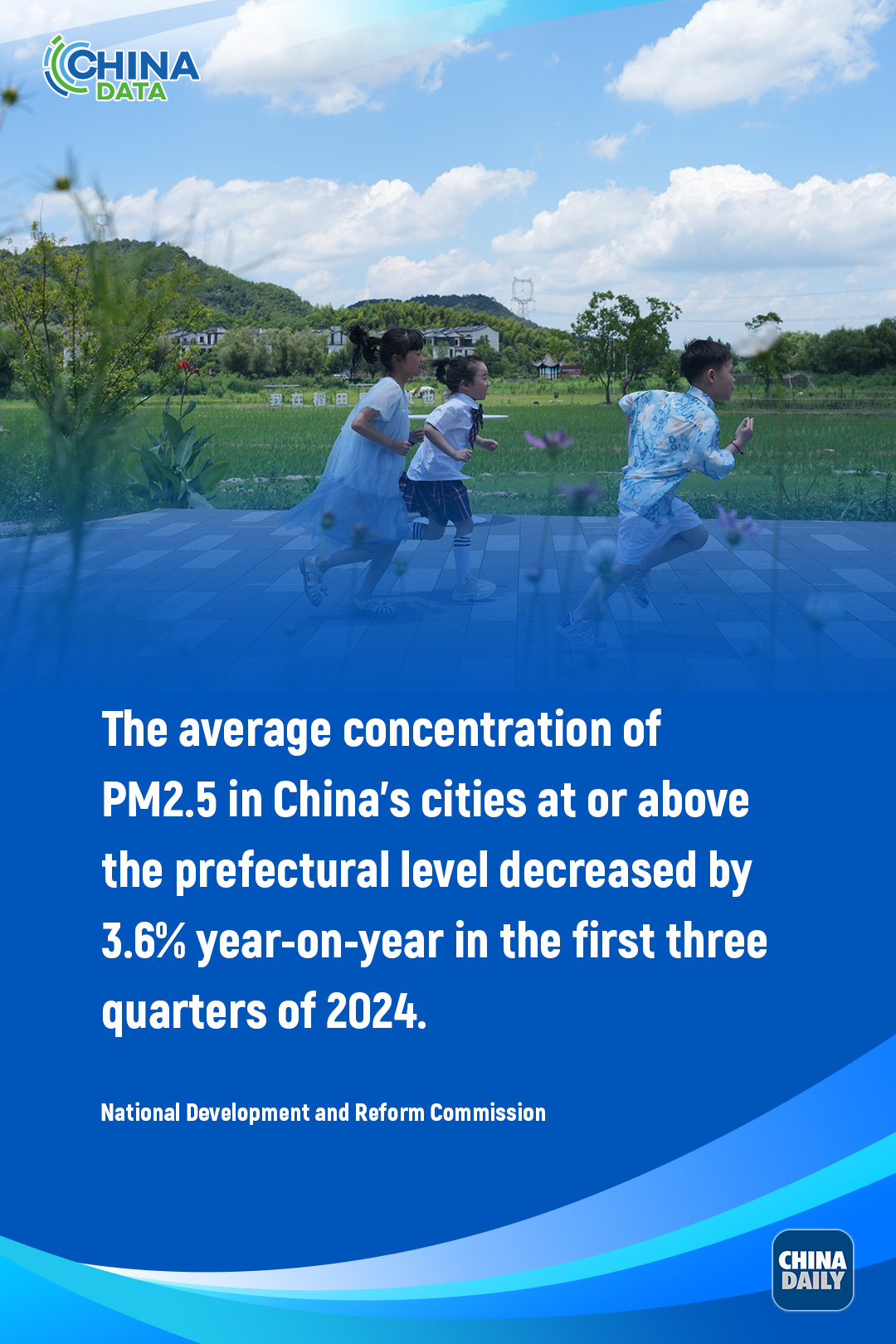
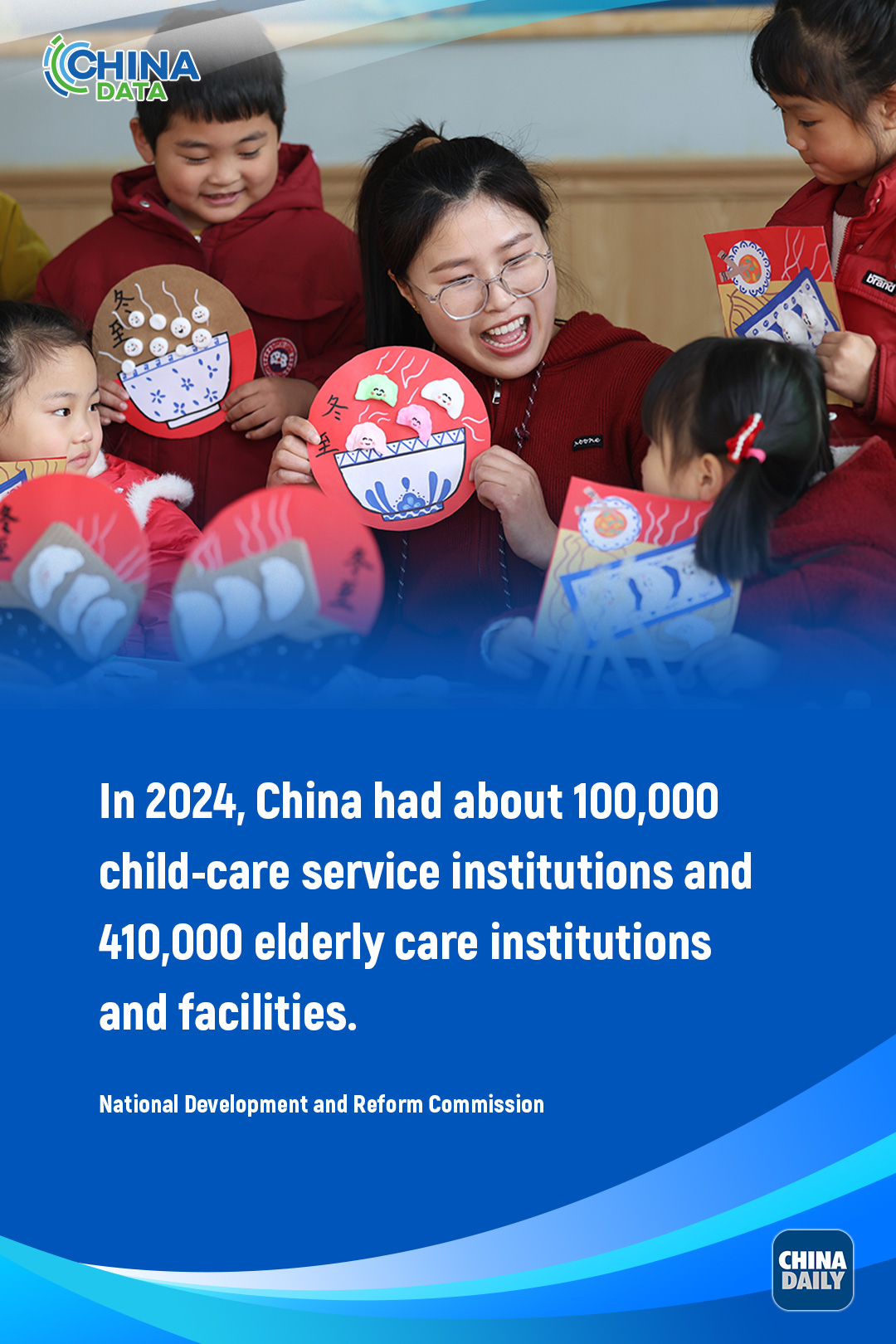
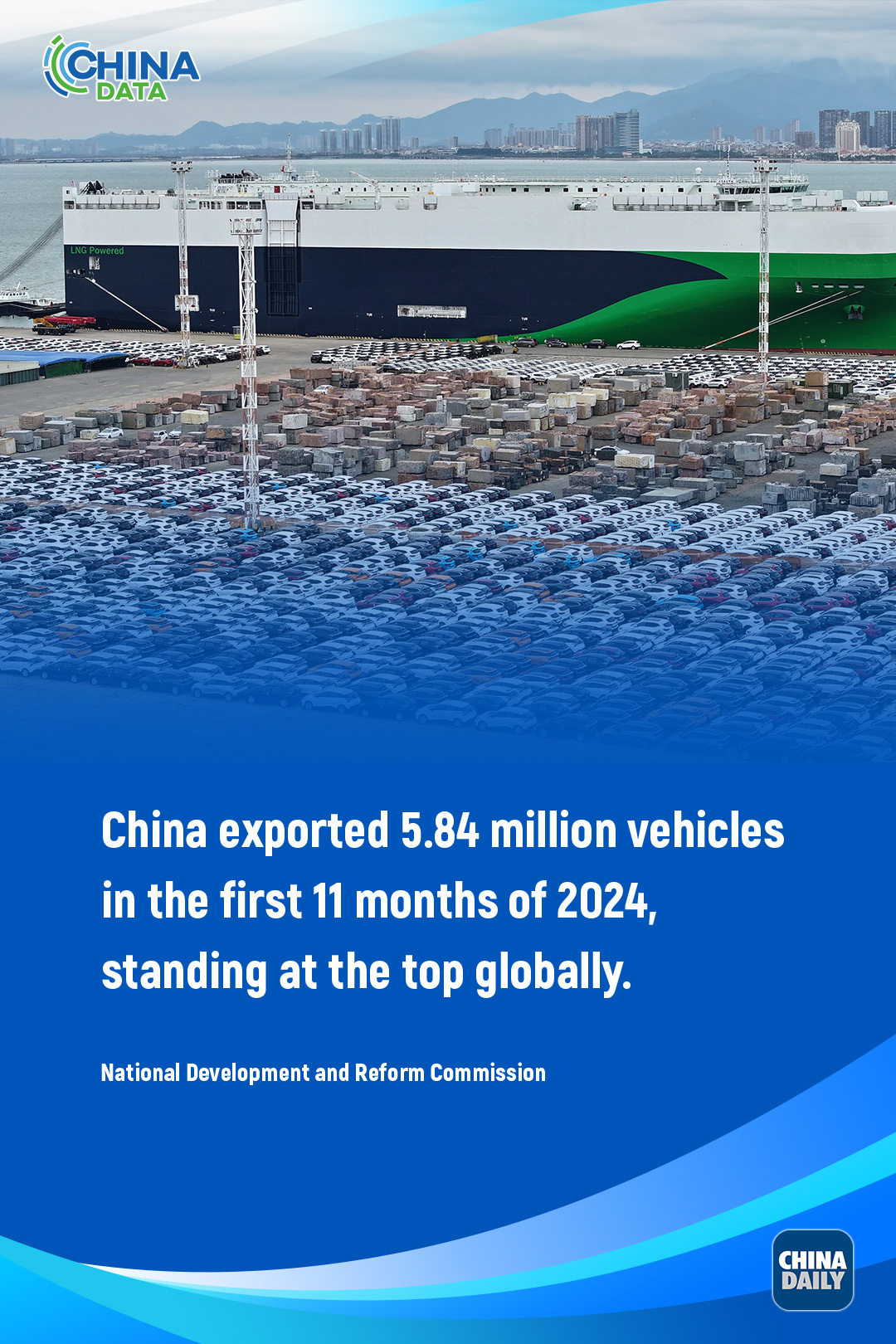
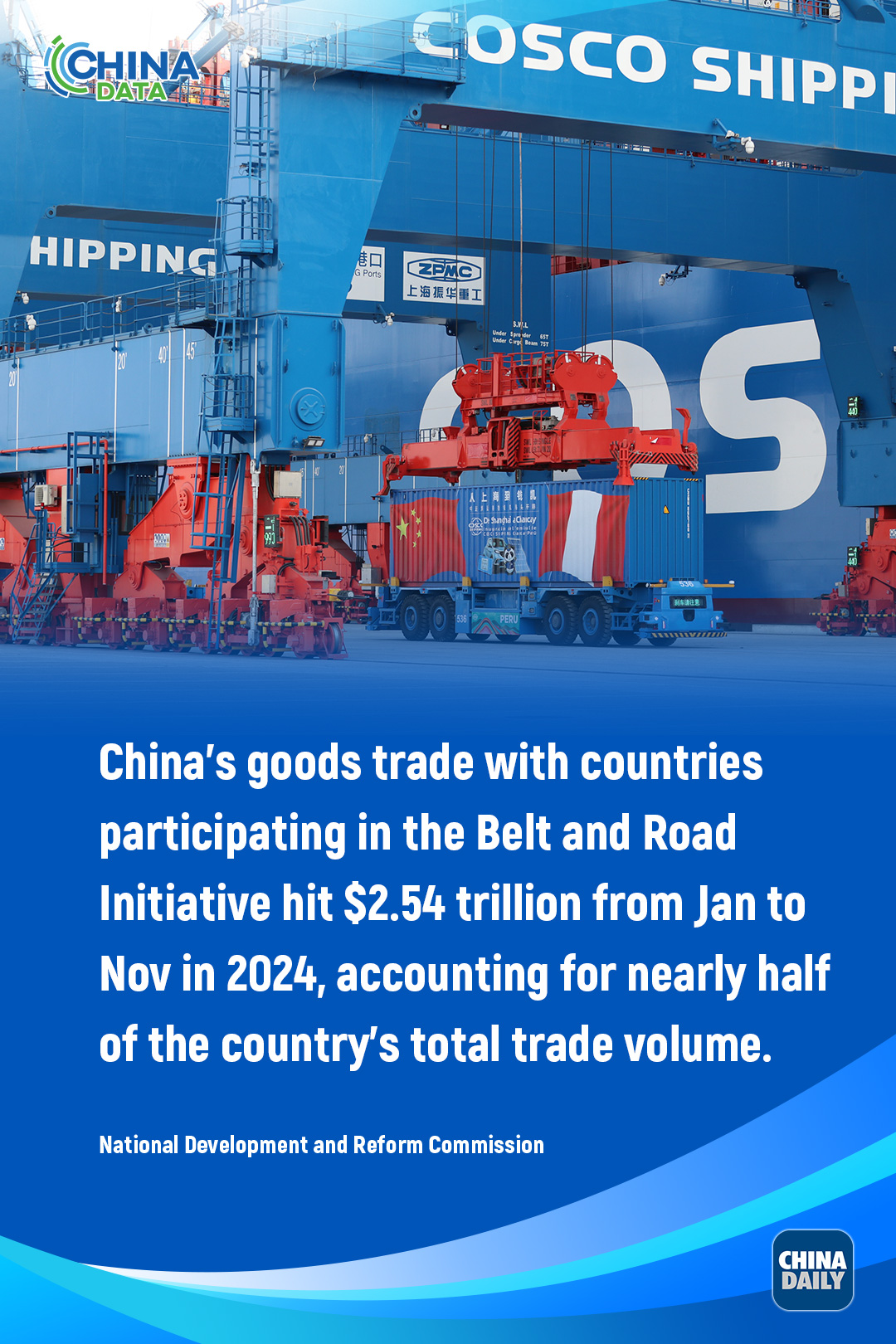
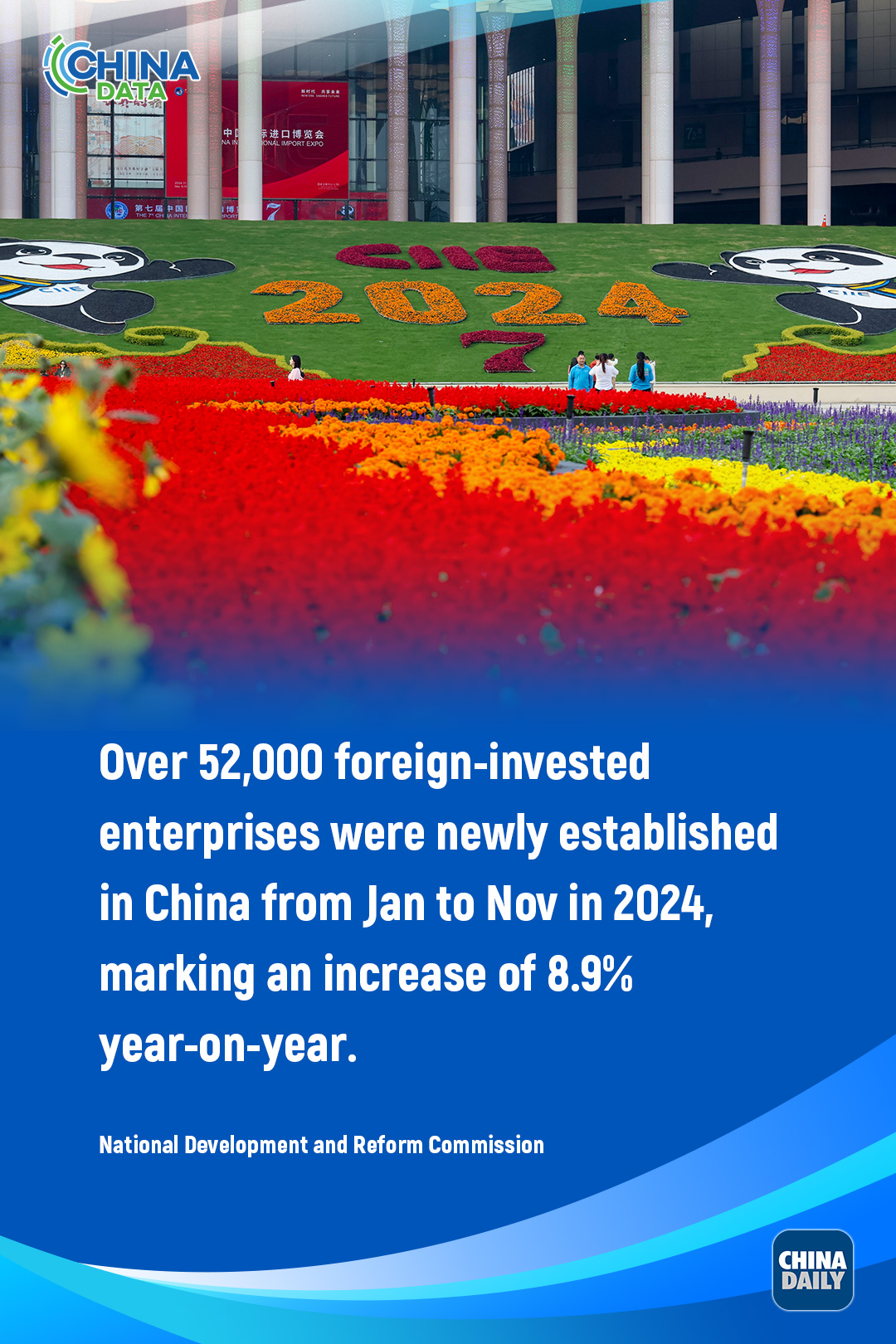

Chinese policymakers will significantly increase the issuance of ultra-long-term special treasury bonds in 2025 to stimulate consumption and fund key national projects, the country's top economic regulator said on Friday.
Economists said it is part of the country's broader efforts to spur domestic demand amid external uncertainties this year, saying policymakers will adopt "more proactive" fiscal and monetary policies to boost domestic consumption and expand effective investment.
Yuan Da, deputy secretary-general of the National Development and Reform Commission, said the special treasury bonds will be used to promote programs for large-scale equipment renewals and trade-in deals for consumer goods and further support major national strategies while building up security capacity in key areas.
"This year, we will extend the programs and expand the scope to more consumption fields," Yuan said at a news conference on Friday in Beijing.
Yuan added that the scope of equipment upgrades will be extended to fields such as electronic information, workplace safety and protected agriculture, while households will be eligible for subsidies to buy three types of digital products this year, including smartphones, tablet computers and smartwatches.
Betty Wang, lead economist at British think tank Oxford Economics, said consumer trade-in programs played a pivotal role in spurring consumption in recent months.
"Retail sales of items included in the trade-in programs, such as household appliances, furniture, construction and decoration materials and electric vehicles grew by an average of 6.8 percent year-on-year during the September-November period, accounting for a quarter of headline retail sales growth," Wang said.
She added that government measures to extend consumer trade-in programs and expand the scope to more products will "help maintain the current momentum of replacing old home appliances and traditional internal-combustion vehicles with EVs in the coming months."
Meanwhile, Wang said more efforts should also be made to support employment and improve the income outlook, which will substantially boost consumer confidence and sentiment.
As of early December, the country had fully allocated all proceeds from last year's 1 trillion yuan ($137 billion) in ultra-long-term special treasury bonds, with around 70 percent of proceeds funding projects for major national strategies and building up security capacity in key areas, and the remainder going toward large-scale equipment renewals and trade-in deals for consumer goods, said the NDRC.
"This year, we expect net financing from central government special bonds to be raised to 1.5 trillion yuan from 1 trillion yuan in 2024," said Lu Ting, chief China economist at Nomura.
Citing the annual Central Economic Work Conference held in December, Lu said policymakers pledged more specific measures to support consumption, including increasing basic pension payments and raising fiscal subsidies for basic medical insurance.
Lu said his team expects Chinese policymakers to consider an increase in spending on social security for lower-income households.
"We especially expect Beijing to significantly increase payments to those rural pensioners (55 percent of total pensioners) whose average monthly pension income is only 225 yuan. Beijing may also waive part of the annual 400-yuan fee on basic medical insurance for low-income individuals," he said.
Looking forward, Lu said "the probability that China will set the GDP growth for 2025 at 'around 5 percent' is on the rise", as the country seeks to extend the economic momentum following some green shoots witnessed in recent months.
Commenting on the annual economic growth target for 2025, Yuan, from the NDRC, said that the country will balance its needs along with medium-to-long-term plans.
Despite facing challenges and difficulties ahead from a more complicated and grimmer external environment, he said the country still enjoys favorable conditions and positive factors.
"By deepening reforms, fostering new quality productive forces in line with local conditions and smoothing out domestic economic circulation, we can effectively unlock the internal driving forces that will propel economic growth," he said.
Yuan added that the country has ample policy space to bolster economic growth. "We are fully confident of promoting sustained economic recovery this year."
Looking ahead, Zhang Ming, deputy director of the Chinese Academy of Social Sciences' Institute of Finance and Banking, said China's annual GDP growth rate is likely to reach 4.7 to 5 percent if the government takes expansionary moves in macroeconomic policy adjustments.
China's policymakers will increase the issuance of ultra-long-term special treasury bonds in 2025, with a broader scope for their expenditure, the country's top economic regulator said on Friday.
Yuan Da, deputy secretary-general of the National Development and Reform Commission, said the special treasury bonds will be used to promote the programs for large-scale equipment renewals and trade-in deals for consumer goods, further support major national strategies and build up security capacity in key areas.
"This year, we will extend the program and expand the scope to more consumption fields," Yuan told a news conference held on Friday in Beijing.
According to Yuan, the scope of equipment upgrades will be extended to fields such as electronic information, safety production, and protected agriculture, while households will be eligible for subsidies to purchase three types of digital products this year, including cell phones, tablet computers, and smartwatches.
Looking into 2025, Yuan said the country will also ramp up efforts to implement major national strategies and build up the security capacity in key areas.
He said the country will continue to support key tasks including ecological and environmental protection and green development in the Yangtze River Economic Belt, new western land-sea corridor, public service systems for the urbanization of rural migrants, and the upgrading of higher education.
The scope of water conservancy support will be extended to medium and large irrigated areas and water diversion projects nationwide. Intercity railway projects in key metropolitan areas will also be included in the list of supported projects, Yuan added.
As of early December, China had fully allocated all proceeds from last year's 1 trillion yuan ($137 billion) in ultra-long-term special treasury bonds, with around 70 percent of proceeds funding projects for major national strategies and building up security capacity in key areas and the remainder going towards the schemes of large-scale equipment renewals and trade-in deals for consumer goods, according to the NDRC.
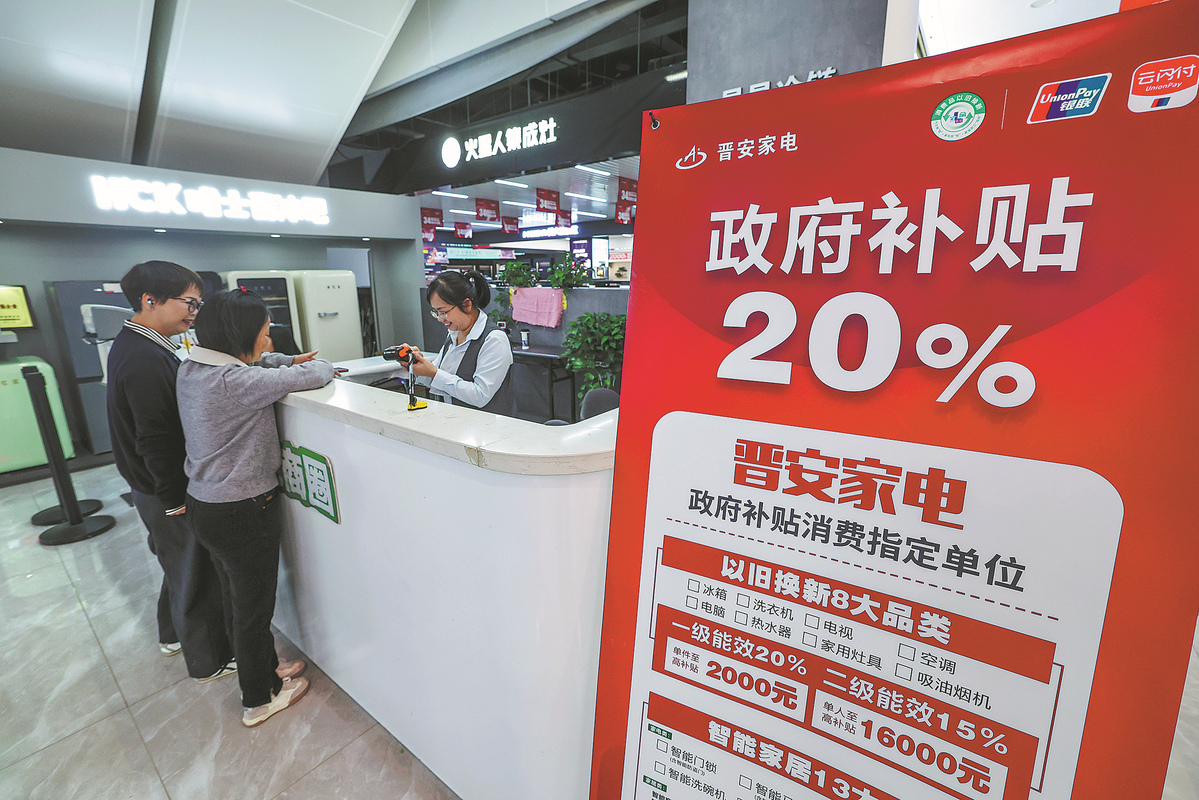
BEIJING -- China will significantly increase the issuance of ultra-long special treasury bonds in 2025 to support the implementation of large-scale equipment upgrades and consumer goods trade-in programs, according to a government press conference held here Friday.
Yuan Da, deputy secretary-general of the National Development and Reform Commission, said the government would expand the scope of areas eligible for funding support, including electronic information, production safety, and agriculture facilities. Consumers will receive subsidies to purchase three categories of digital products: mobile phones, tablets, and smartwatches and wristbands.
The official said that the government will further increase subsidies for upgrading new energy city buses, batteries, and agricultural machinery and strengthen support for renewing home decoration-related consumer goods.
In March 2024, the government launched an action plan to promote large-scale equipment renewal and trade-in of consumer goods as part of efforts to boost domestic demand and support economic growth.
Yuan said that over the past year, work related to these programs has effectively shored up investment, boosted household consumption, and accelerated the green transition.
